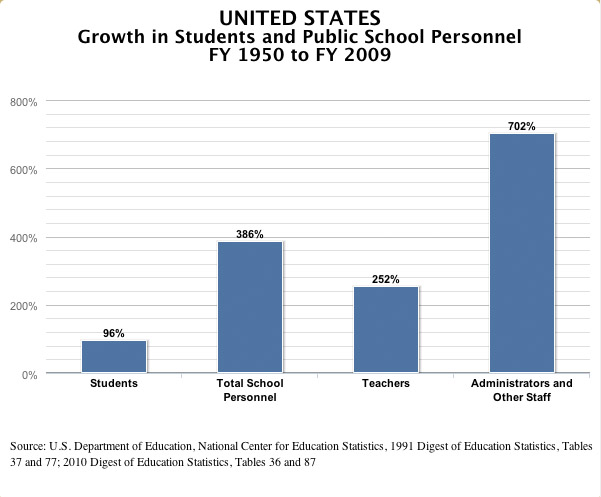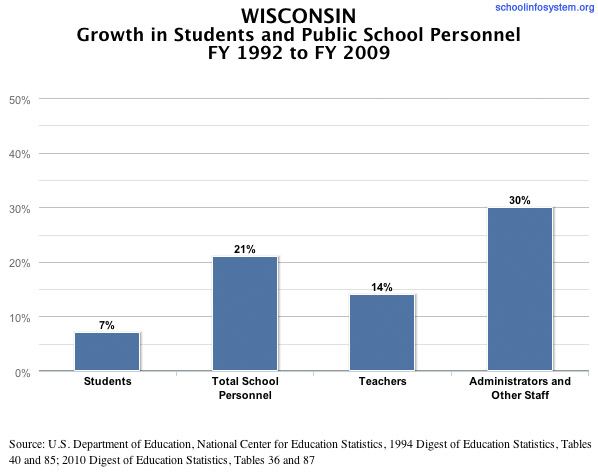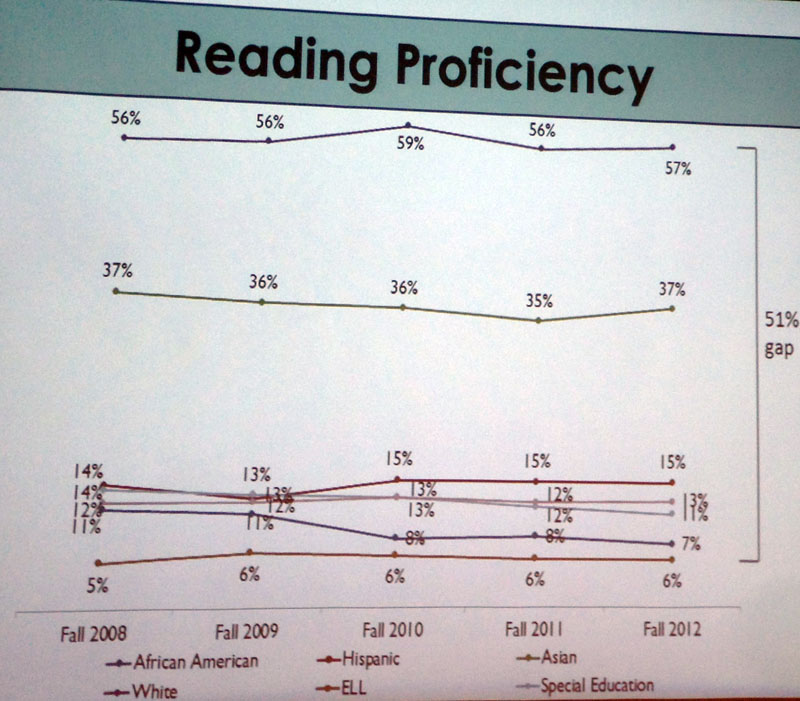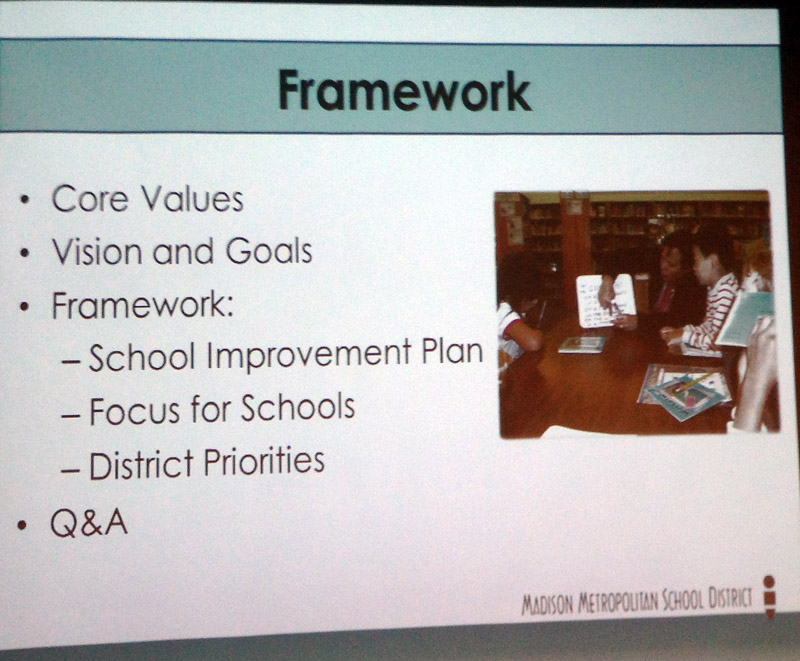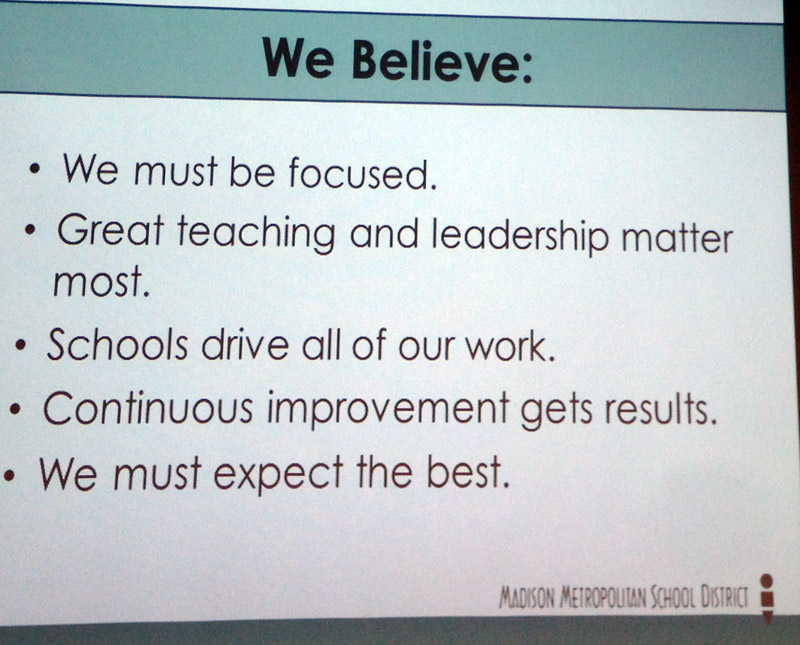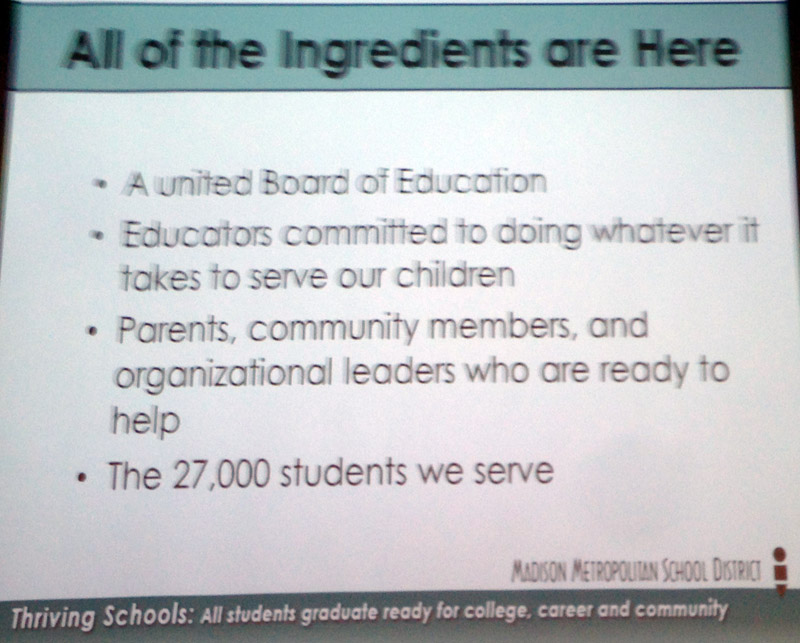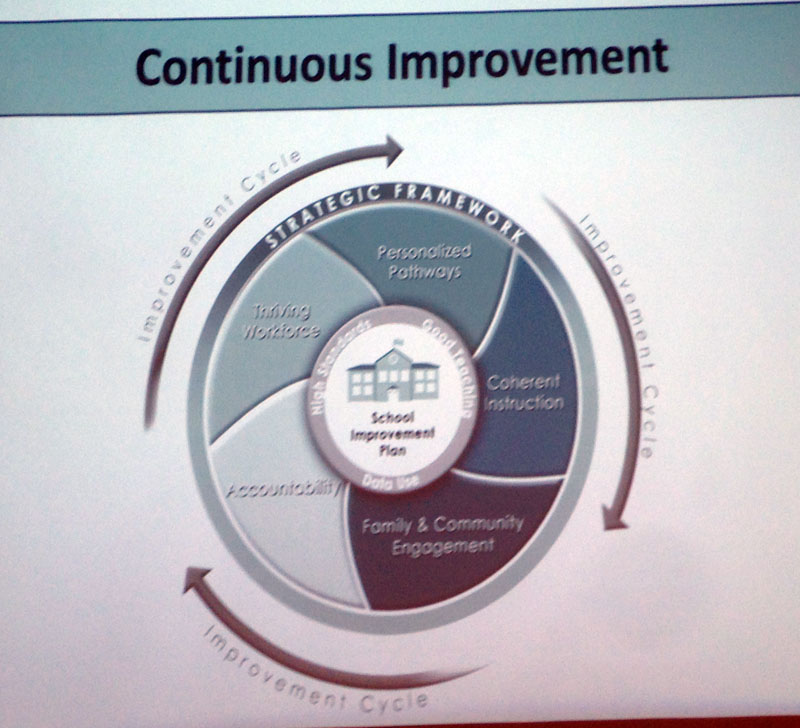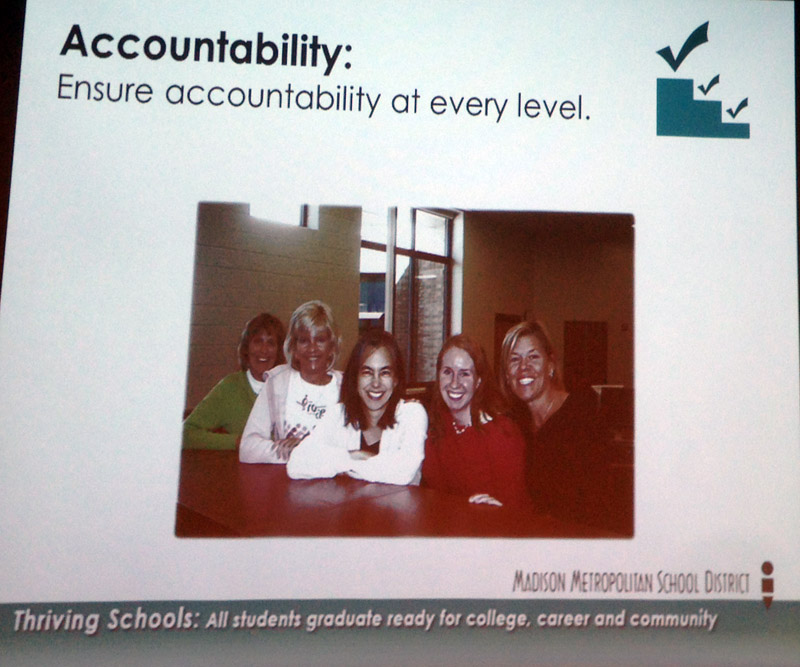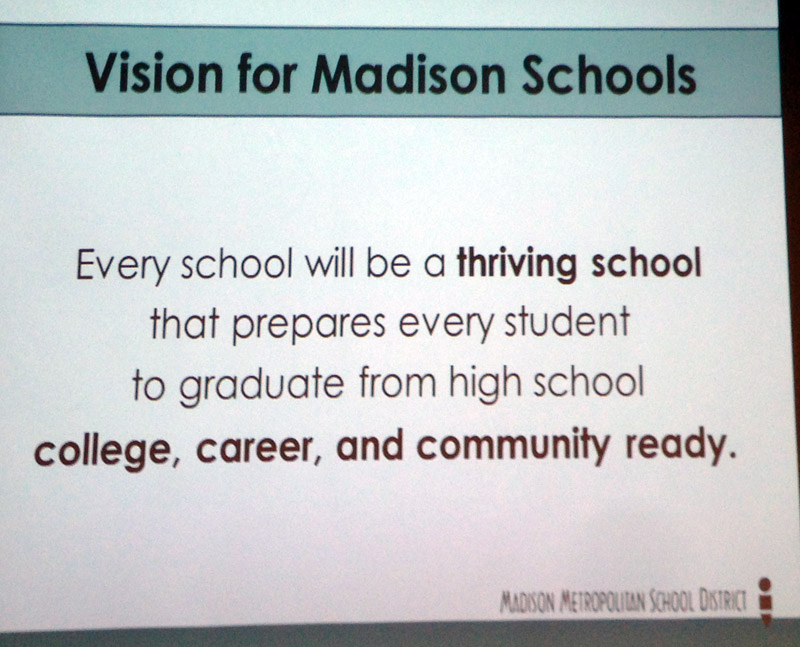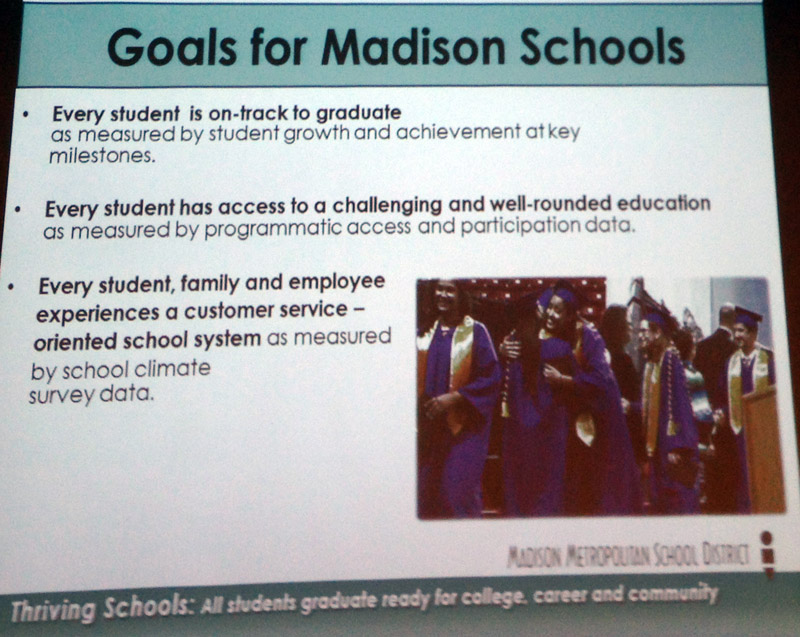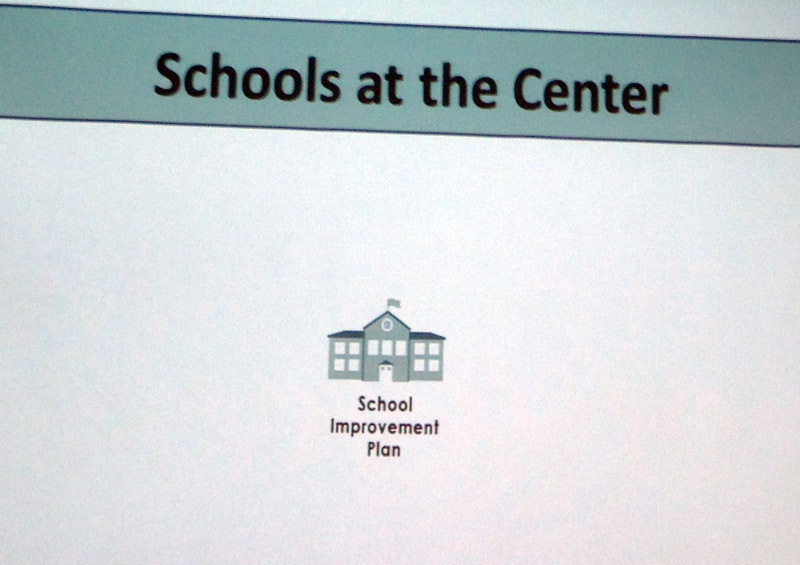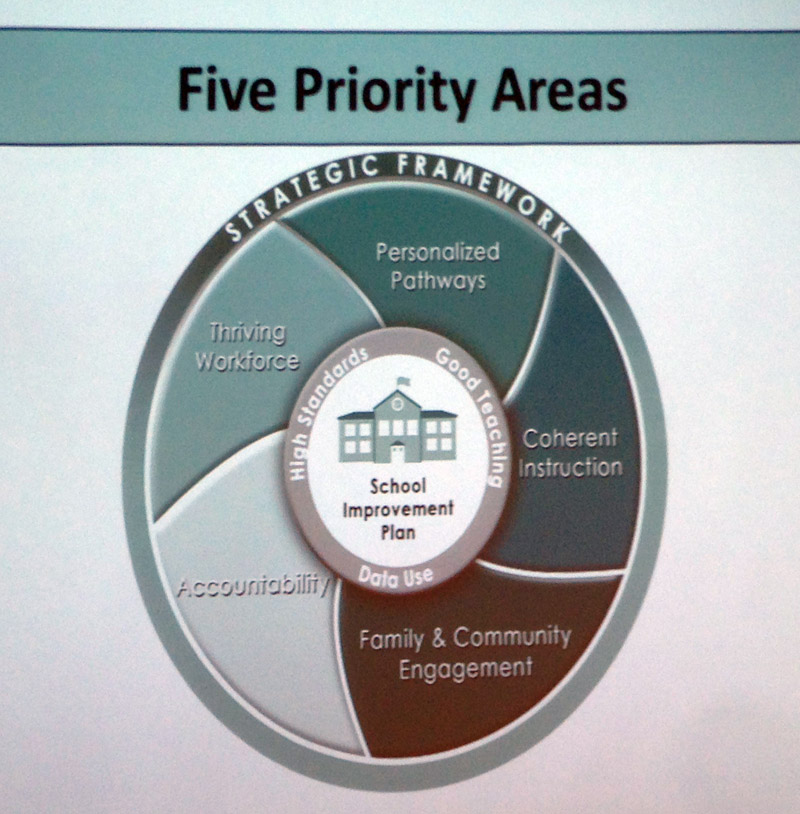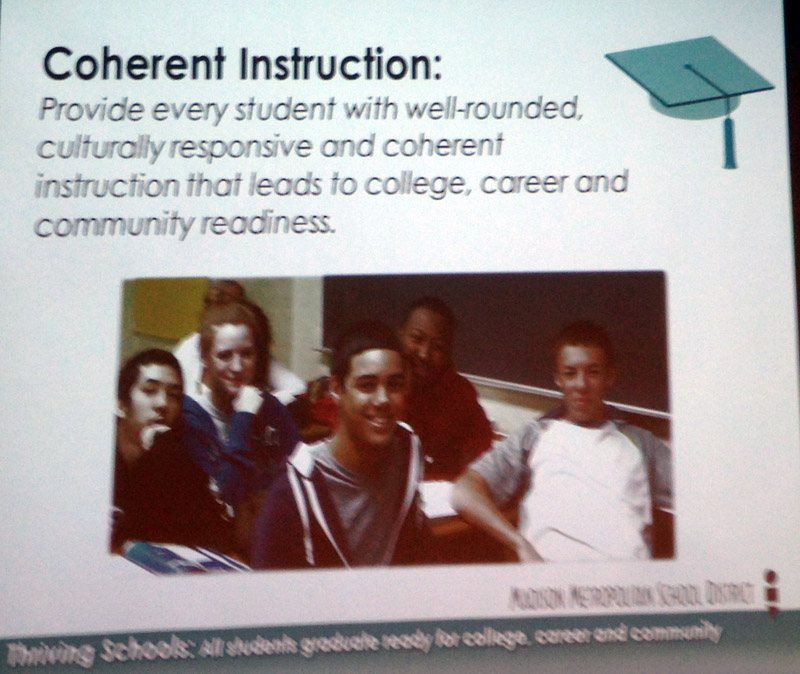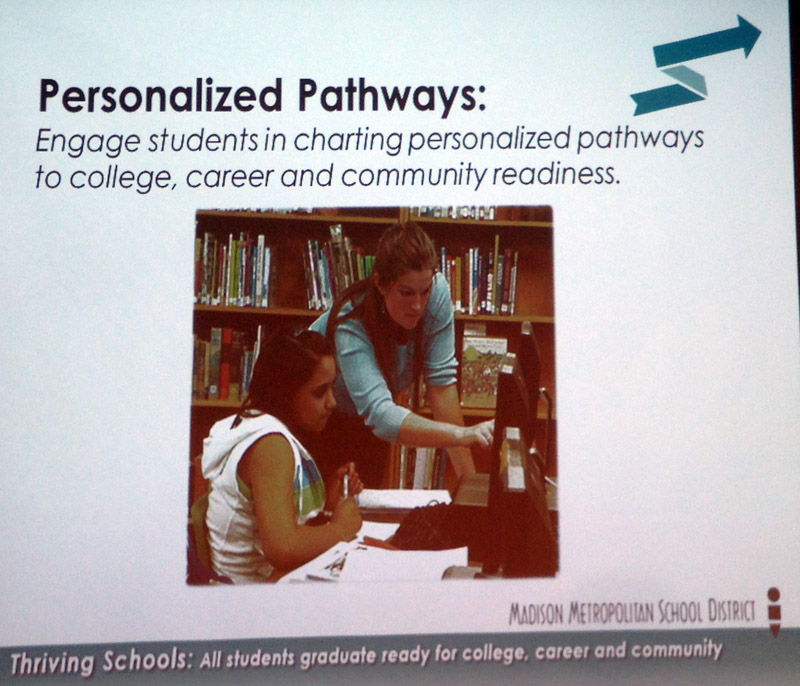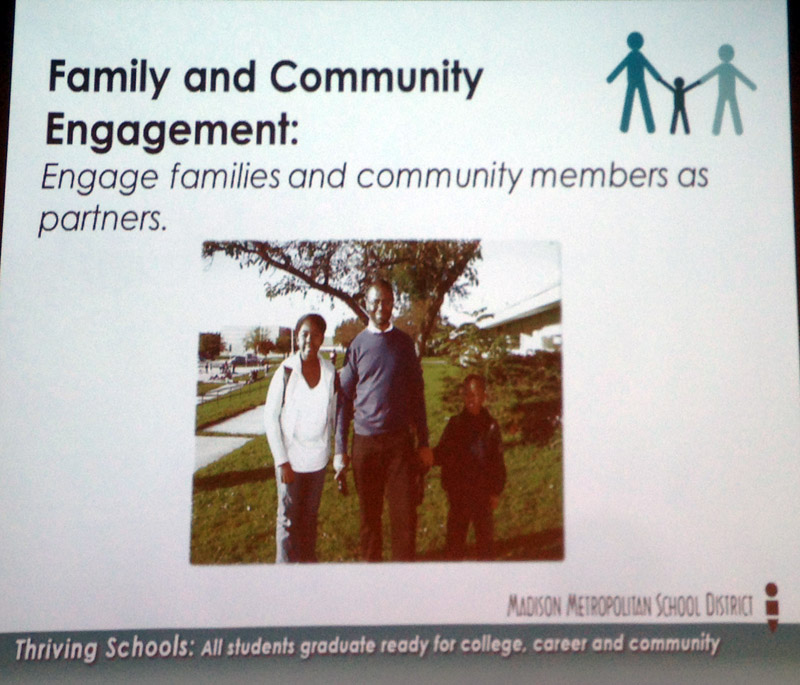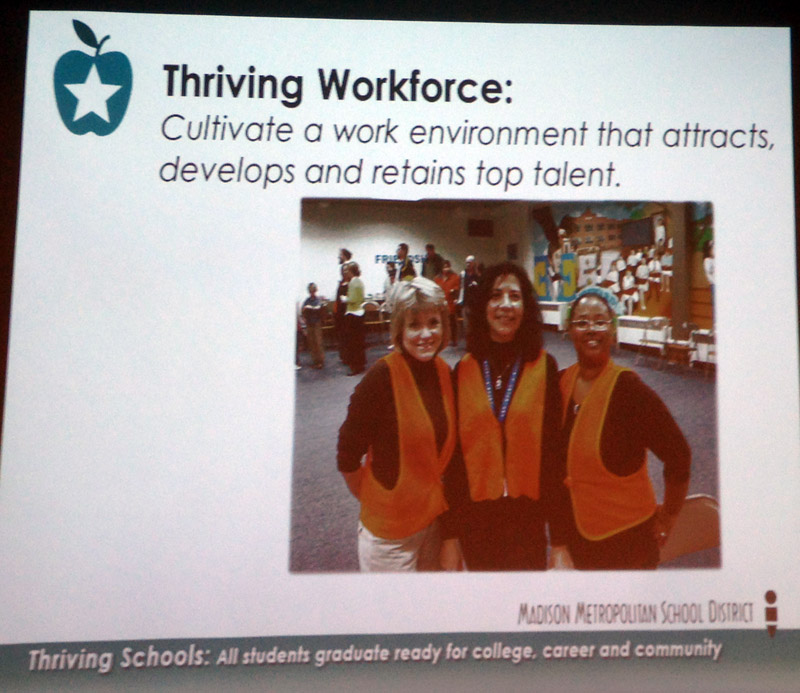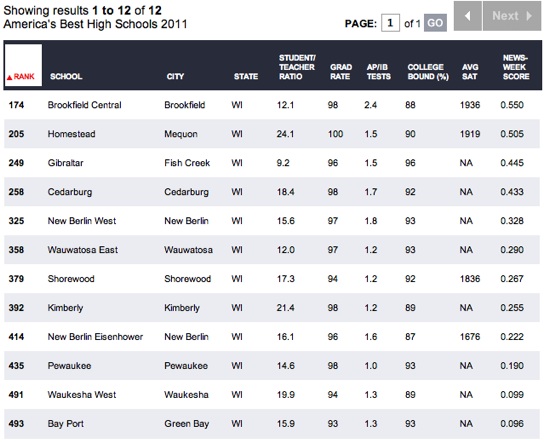Search Results for: Administrator growth
The growth of diversity administrators
Jay Greene & James Paul: The promotion of diversity, equity, and inclusion (DEI) on college campuses has become a central concern of higher education. However, high DEI staffing levels suggest that these programs are bloated relative to academic pursuits and do not contribute to reported student well-being on campus. The authors’ research suggests that large […]
Best Practices for “Human Growth & development
WILL: Wisconsin Statute § 118.019 governs human growth and development (HGD) instruction. This isessentially the sex education curriculum in Wisconsin. Public school districts are not required to adopt an HGD curriculum, but once they do, certain requirements are triggered. ADVISORY COMMITTEE ROLE AND REQUIREMENTSThe advisory committee MUST be made up of parents, teachers, school administrators, […]
West Virginia University Banked on Growth. It Backfired.
Melissa Korn and Kris Maher: West Virginia University’s student population has been shrinking for years. Its proclivity to spend money has not. Now facing a $45 million budget deficit, administrators have proposed eliminating dozens of programs, including the mathematics Ph.D. and the entire world languages department. Students staged a spirited protest on campus last week, […]
Ongoing Taxpayer supported Madison K-12 school spending growth: 2022-2023 budget (amidst declining enrollment)
Elizabeth Beyer: An average home valued at $376,765 could see a property tax increase of up to $106, meaning the school portion of the tax bill would be roughly $3,926 in December, compared with $3,820 this past year. The district’s total property tax levy would increase 2.77% over the previous year, to roughly $366.8 million. […]
Growth in Administrative Staff, Assistant Principals Far Outpaces Teacher Hiring
Ira Stoll: Labor Department counts 271,020 K-12 “education administrators,” with an average wage of more than $100,000 a year. Are schools really spending more on administration than they used to? The short answer is yes. A recent Education Next blog post, “Could Covid Finally Disrupt the Top-Down Education Bureaucracy?” by the founder of the Campaign for Common […]
Commentary on Madison Government Schools’ Tax & Spending Growth (Lacks total expenditures)
Christ Rickert As a Madison School District taxpayer, I appreciate the School Board’s careful consideration of whether the Nov. 8 election would be too soon to ask voters to approve a referendum. When you’re an elected official overseeing a $376 million operating budget and the educational lives of some 27,000 students, you can’t take the […]
Why Not Adjunct Administrators Instead of Adjunct Instructors? It Makes Far More Sense
Scott Rank: Most of the growth of university costs comes from administrative bloat. Non-faculty staff has grown at more than twice the rate of instructors – you know, the people who are the ostensible reason a university exists. As tenured professors retire, administrators kill those tenure lines and replace them permanently with part timers. Administrators […]
The School Staffing Surge: Decades of Employment Growth in America’s Public Schools, Part II
America’s K-12 public education system has experienced tremendous historical growth in employment, according to the U.S. Department of Education’s National Center for Education Statistics. Between fiscal year (FY) 1950 and FY 2009, the number of K-12 public school students in the United States increased by 96 percent, while the number of full-time equivalent (FTE) school employees grew 386 percent. Public schools grew staffing at a rate four times faster than the increase in students over that time period. Of those personnel, teachers’ numbers increased 252 percent, while administrators and other non-teaching staff experienced growth of 702 percent, more than seven times the increase in students.
That hiring pattern has persisted in more recent years as well. Between FY 1992 and FY 2009, the number of K-12 public school students nationwide grew 17 percent, while the number of FTE school employees increased 39 percent. Among school personnel, teachers’ staffing numbers rose 32 percent, while administrators and other non-teaching staff experienced growth of 46 percent, 2.3 times greater than the increase in students over that 18-year period; the growth in the number of teachers was almost twice that of students.
The two aforementioned figures come from “The School Staffing Surge: Decades of Employment Growth in America’s Public Schools.” This companion report contains more state-specific information about public school staffing. Specifically, this report contains:Related: Richard Zimman’s 2009 speech to the Madison Rotary Club
The School Staffing Surge: Decades of Employment Growth in America’s Public Schools, Part II
America’s K-12 public education system has experienced tremendous historical growth in employment, according to the U.S. Department of Education’s National Center for Education Statistics. Between fiscal year (FY) 1950 and FY 2009, the number of K-12 public school students in the United States increased by 96 percent, while the number of full-time equivalent (FTE) school employees grew 386 percent. Public schools grew staffing at a rate four times faster than the increase in students over that time period. Of those personnel, teachers’ numbers increased 252 percent, while administrators and other non-teaching staff experienced growth of 702 percent, more than seven times the increase in students.
That hiring pattern has persisted in more recent years as well. Between FY 1992 and FY 2009, the number of K-12 public school students nationwide grew 17 percent, while the number of FTE school employees increased 39 percent. Among school personnel, teachers’ staffing numbers rose 32 percent, while administrators and other non-teaching staff experienced growth of 46 percent, 2.3 times greater than the increase in students over that 18-year period; the growth in the number of teachers was almost twice that of students.
The two aforementioned figures come from “The School Staffing Surge: Decades of Employment Growth in America’s Public Schools.” This companion report contains more state-specific information about public school staffing. Specifically, this report contains:
On US K-12 Staff Growth: Greater than Student Growth
In a recent opinion piece, James L. Huffman requests Oregonians to ask “why those who run our public schools have seen fit to increase their own ranks at three times the rate of growth in student enrollment while allowing for a small decline in the number of teachers relative to students” (“Oregon’s schools: Are we putting money into staff at students’ expense?” Commentary, Nov. 17).
He references a report by the Friedman Foundation for Educational Choice that uses data from the National Center for Education Statistics to document that K-12 personnel growth has outstripped K-12 student enrollment growth. The data are completely accurate, but the conclusions Huffman and the report reach are erroneous.
Huffman writes that some might be suspicious of the foundation as the source of the data. In reading the report’s conclusion (pages 19-22), such suspicion is justified.Related: The School Staffing Surge: Decades of Employment Growth in America’s Public Schools:
America’s K-12 public education system has experienced tremendous historical growth in employment, according to the U.S. Department of Education’s National Center for Education Statistics. Between fiscal year (FY) 1950 and FY 2009, the number of K-12 public school students in the United States increased by 96 percent while the number of full-time equivalent (FTE) school employees grew 386 percent. Public schools grew staffing at a rate four times faster than the increase in students over that time period. Of those personnel, teachers’ numbers increased 252 percent while administrators and other staff experienced growth of 702 percent, more than seven times the increase in students.
In a recent Heritage Foundation Backgrounder, Lindsey Burke (2012) reports that since 1970, the number of students in American public schools increased by 8 percent while the number of teachers increased 60 percent and the number of non-teaching personnel increased 138 percent.
That hiring pattern has persisted in more recent years as well. This report analyzes the rise in public school personnel relative to the increase in students since FY 1992. Analyses are provided for the nation as a whole and for each state.
Between FY 1992 and FY 2009, the number of K-12 public school students nationwide grew 17 percent while the number of full-time equivalent school employees increased 39 percent, 2.3 times greater than the increase in students over that 18-year period. Among school personnel, teachers’ staffing numbers rose 32 percent while administrators and other staff experienced growth of 46 percent; the growth in the number of administrators and other staff was 2.7 times that of students.1.2MBPDF report and,
Ripon Superintendent Richard Zimman:“Beware of legacy practices (most of what we do every day is the maintenance of the status quo), @12:40 minutes into the talk – the very public institutions intended for student learning has become focused instead on adult employment. I say that as an employee. Adult practices and attitudes have become embedded in organizational culture governed by strict regulations and union contracts that dictate most of what occurs inside schools today. Any impetus to change direction or structure is met with swift and stiff resistance. It’s as if we are stuck in a time warp keeping a 19th century school model on life support in an attempt to meet 21st century demands.” Zimman went on to discuss the Wisconsin DPI’s vigorous enforcement of teacher licensing practices and provided some unfortunate math & science teacher examples (including the “impossibility” of meeting the demand for such teachers (about 14 minutes)). He further cited exploding teacher salary, benefit and retiree costs eating instructional dollars (“Similar to GM”; “worry” about the children given this situation).
Stats show alarming growth in violent racial and girl-on-girl incidents, including Blair’s ‘Day of Six Fights’
The expulsion of four elementary school students for bringing knives onto campus and a rise in violence involving female African-American students have left city and school officials scrambling for solutions.
Records obtained by the Pasadena Weekly show that more than half of the 31 students expelled from the start of the school year through March were African American, and 11 of those 17 kids were girls, including five former students of Blair International Baccalaureate Magnet School who were involved in what has come to be known by teachers, students and administrators as “The Day of Six Fights” on Feb 18.
Although all those incidents involved weapons or violence or both, and a multijurisdictional board had been working since October on combating instances of youth- and gang-related violence, that information was not shared with the former 14-member Committee on Youth Development and Violence Prevention — even though that board included two sitting members of the Board
of Education, which ultimately approved all of the expulsions.
Further, the Pasadena Unified School District has few programs in place to address the rise in violence and no facilities available to help with the increase in expulsions from the district’s elementary schools.The Madison School District’s Security Coordinator, Luis Yudice mentioned increased school violence involving girls during meeting on West High School / Regent area neighborhood crime last fall.
Denver Schools Get Bonuses for Student Population Growth
Allison Sherry: Some of the Denver’s most popular public schools will get pots of cash this spring for attracting students from out of the district or from charter schools. The move is designed to draw students back to Denver public schools, which have lost more than 8,000 students in the past six years. Places like […]
Are Administrators Golden?
Next year’s projected operating budget shortfall is $8 million – projected expenses will exceed revenues by that amount. For 13 years the growth in expenses have exceeded what the district received and was allowed to receive from the a) state and federal government revenues and b) allowed growth in revenues from property taxes. Further, the […]
mentoring
Sophia Damian: The original purpose of the university was simple: the academic formation of its students. Over the past several decades, however, society’s perception of higher-education institutions has grown to encompass numerous aspects of student development, including career preparation. A similar shift has occurred on a smaller scale where the role of professors is concerned. […]
Yale administrative bloat
Alex Tabarrok: Yale has approximately one administrator for every undergraduate student (see also here and here). Years of simmering tension about the growth of administration relative to faculty has now been brought forward. President Trump has threatened to cut funding to Yale, the Yale administration has threatened to stop hiring faculty and raises, some faculty are now threatening to revolt. Over […]
Student activism at Brown University 
Alex Shieh: Around 2 a.m. on an otherwise unremarkable Tuesday, I launched a public database mapping all 3,805 non-faculty employees of Brown University and sent each one a simple email: What do you do all day? Ostensibly, it was a journalistic inquiry. The site, which I named Bloat@Brown, was somewhere between FaceMash (Mark Zuckerberg’s college […]
Bureaucratic bloat has siphoned power away from instructors and researchers
Derek Thompson Last month, the Pomona College economist Gary N. Smith calculated that the number of tenured and tenure-track professors at his school declined from 1990 to 2022, while the number of administrators nearly sextupled in that period. “Happily, there is a simple solution,” Smith wrote in a droll Washington Postcolumn. In the tradition of Jonathan Swift, his […]
Wisconsin’s Act 10, Flexible Pay, and the Impact on Teacher Labor Markets: Student test scores rise in flexible-pay districts. So does a gender gap for teacher compensation.
Barbara Biasi Using employment records on all public-school teachers in Wisconsin linked to individual student information on achievement and demographics from the Wisconsin Department of Public Instruction, I first document how teacher salaries changed in flexible-pay and seniority-pay districts in the aftermath of the reform. After the expiration of districts’ collective bargaining agreements, salary differences […]
The Massachusetts Institute of Technology now has almost eight times as many nonfaculty employees as faculty employees.
David Brooks: The growth of bureaucracy costs America over $3 trillion in lost economic output every year, Gary Hamel and Michele Zanini estimated in 2016 in The Harvard Business Review. That was about 17 percent of G.D.P. According to their analysis, there is now one administrator or manager for every 4.7 employees, doing things like designing anti-harassment […]
“Districts seeing a 10% decline in enrollment, for example, are almost two times more likely to go to referendum than districts with rising enrollments”
Abbey Machtig: The Madison School District is in the middle of two referendums approved by voters in 2020. The $317 million capital referendum has gone toward building a new elementary school and funding significant high-school renovations. The smaller operating referendum gave the district an additional $33 million to work with over four years. Despite this […]
Instructional Coach Kyle Thayse Wisconsin Education Committee Testimony; Q&A; Lucy Calkins
Transcript mp3 Audio Entire hearing video. An interesting excerpt, regarding their use of the discredited Lucy Caulkins Reading Curriculum (see Sold a Story): Senator John Jagler. Thank you. I, as I talked to, to my local administrators, [00:21:00] um, I’m fascinated. Curriculum choices that have been made and continue to be made. [00:21:06] And I’m, […]
Self-inflicted wounds, not changing demographics, are undermining the higher-ed sector.
Richard Vedder: So how are colleges killing themselves, committing unintentional suicide? Five ways. First are the high fees they charge. The tuition fees of colleges today are nearly triple what they were a half-century ago after correcting for inflation. [Editor’s note: Cheers to UNC for freezing tuition for the seventh year in a row.] Since the 1980s, the rise […]
Eugenicists also believed that science is real
Robert F. Graboyes: “Be skeptical of everything you hear, including this sentence.” That was the central message of the 48 semester-long classes I taught to medical professionals—doctors, nurses, therapists, administrators, etc. over 19 years. Officially, my courses were on the economics of healthcare, but they also encompassed ethics and a much broader look at epistemology […]
Oak Park, River Forest Schools and race based grading
West Cook News: Oak Park and River Forest High School administrators will require teachers next school year to adjust their classroom grading scales to account for the skin color or ethnicity of its students. School board members discussed the plan called “Transformative Education Professional Development & Grading” at a meeting on May 26, presented by […]
Crises of Elite Competition in the East and West
Malcom Kyeyune and Marty MacMarty: Although this educational paradigm is often seen in the West as an outgrowth of the “Confucian model” of education, this is in some ways the opposite of the truth. There are, broadly speaking, two types of education, defined in terms of their method and purpose. In the first model, which […]
Universities’ Insane COVID Rules and Snitch Culture Are Training the Next Generation to Embrace Totalitarianism
Evita Duffy: If you think state and federal government COVID-19 policies are too restrictive, you haven’t been to a college campus lately. Schools across the country have imposed extreme, micromanaging rules on 19-22 year olds—a demographic more likely to die from the seasonal flu and pneumonia than COVID. Paying top dollar at already overpriced institutions for vastly inferior remote […]
The Impact of Chief Diversity Officers on Diverse Faculty Hiring
Steven W. Bradley, James R. Garven, Wilson W. Law & James E. West: As the American college student population has become more diverse, the goal of hiring a more diverse faculty has received increased attention in higher education. A signal of institutional commitment to faculty diversity often includes the hiring of an executive level chief […]
Covid-19 and Madison’s K-12 World
Hi, I’m cap tines K-12 education reporter Scott Gerard. Today. Our cap times IDFs panel will discuss how will COVID-19 change K-12 education. I’m lucky to have three wonderful panelists with me to help answer that question. Marilee McKenzie is a teacher at Middleton’s Clark street community school, where she has worked since the school was in its planning stages.
She’s in her [00:03:00] 11th year of teaching. Dr. Gloria Ladson billings is a nationally recognized education expert who was a U w Madison faculty member for more than 26 years, including as a professor in the departments of curriculum and instruction, educational policy studies and educational leadership and policy analysis.
She is also the current president of the national Academy of education. Finally dr. Carlton Jenkins is the new superintendent of the Madison metropolitan school district. He started the districts top job in August, coming from the Robbinsdale school district in Minnesota, where he worked for the past five years, Jenkins began his career in the Madison area.
Having worked in Beloit and at Memorial high school in early 1990s before moving to various districts around the country. Thank you all so much for being here. Mary Lee, I’m going to start with you. You’ve been working with students directly throughout this pandemic. How has it gone? Both in the spring when changes were very sudden, and then this fall with a summer to reflect and [00:04:00] plan, it’s been interesting for sure.
Um, overall, I would say the it’s been hard. There has been nothing about this have been like, ah, It’s really, it makes my life easy. It’s been really challenging. And at the same time, the amount of growth and learning that we’ve been able to do as staff has been incredible. And I think about how teachers have moved from face-to-face to online to then planning for.
Edgewood College reinstates terminated faculty following appeals process
Yvonne Kim: Edgewood College has reinstated the positions of all six Edgewood College professors who were initially terminated in May. One anonymous professor and English and ethnic studies professor Huining Ouyang learned this week that the Board of Trustees decided to rescind their termination notices, while communications professor Bonnie Sierlecki had not yet directly heard […]
Survey sent to Madison teachers details potential for cuts
Scott Girard: A survey from Madison Metropolitan School District administration outlines the potential for more budget cuts coming amid the COVID-19 pandemic, with wage freezes and staff cuts among the options administrators are considering. The two-question survey, sent to staff Friday, states that the district expects an additional $5 million to $9 million budget cut […]
UW-Madison job title, pay review project approaches final stages before 2020 implementation
Yvonne Kim: The project plans to reduce nearly half of approximately 1,600 current job titles and include a new, specific job description for each new title, said chief human resources officer Mark Walters. This includes 24 designated job groups, 116 sub-groups and 645 draft descriptions, according to the website. Next steps include meeting with all […]
Neo-Segregation at Yale
National Association of Scholars: Today the National Association of Scholars is releasing its latest report: Neo-Segregation at Yale. The report is part of a much larger project titled, Separate but Equal, Again: Neo-Segregation in American Higher Education. This project studies and documents the growth of neo-segregation on American college campuses through case studies and a […]
Inside the Academic Destruction of the University of Tulsa
Jacob Howland: Harvard Business School professor recently predicted that up to half of all American colleges and universities will go bankrupt in the next ten to 15 years. While this may be a worst-case scenario, universities have for years been offering an increasingly inferior product at unsustainably high prices to an ever-more skeptical group of […]
In Milwaukee, Montessori schools are delivering what parents want
Alan Borsuk: But it is not easy to create or sustain a Montessori school with quality. A lot depends on having teachers and principals who are trained in the approach. They are in limited supply, a factor that holds down growing the number of schools. A fresh piece of good news for Montessori in Milwaukee: […]
The Decline of Historical Thinking
Eric Alterman: I do not refer to the obvious and ineluctable fact that some people are smarter than others but, rather, to the fact that some people have the resources to try to understand our society while most do not. Late last year, Benjamin M. Schmidt, a professor of history at Northeastern University, published a […]
The Impact of Chief Diversity Officers on Diverse Faculty Hiring
Steven W. Bradley, James R. Garven, Wilson W. Law, James E. West: As the American college student population has become more diverse, the goal of hiring a more diverse faculty has received increased attention in higher education. A signal of institutional commitment to faculty diversity often includes the hiring of an executive level chief diversity […]
Ben Weingarten interviews writer and scholar Victor Davis Hanson on the decline of the American academy, the Democratic Party, and President Trump.
The Federalist: Ben Weingarten: As a classicist, you’ve lamented both the corruption of the academy within your own discipline and on the modern campus more broadly — in particular on its repudiation of the Western canon, its lack of adherence to principles of free inquiry and the overall triumph of progressivism. Is there any way […]
“the number of teachers was growing faster than student enrollment”
Mike Antonucci “Financially it’s a ticking time bomb, we think,” Ingersoll said. “The main budget item in any school district is teachers’ salaries. This just can’t be sustainable.” It’s easy to see what Ingersoll means. NCES produces its survey every four years. Almost all public school staffing took a hit during the 2012 survey, as […]
The Changing of the Guard: The Political Economy of Administrative Bloat in American Higher Education
Todd J. Zywicki and Christopher Koopman: The cost of higher education in the United States has risen dramatically in recent years. Numerous explanations have been provided to explain this increase. This paper focuses on one contributing factor: The dramatic growth in the size and expense of non-academic administrators and other university bureaucrats, which has outpaced […]
Ivy League Summary: Tax Break Subsidies And Government Payments
Open the books: KEY FINDINGS: 1. Ivy League payments and entitlements cost taxpayers $41.59 billion over a six-year period (FY2010-FY2015). This is equivalent to $120,000 in government monies, subsidies, & special tax treatment per undergraduate student, or $6.93 billion per year. 2. The Ivy League was the recipient of $25.73 billion worth of federal payments […]
Management Bloat at UC – How Big is it? Where is it? Why is it?
Charles Schwartz: Previous studies are extended to show a 24-year history of runaway growth in Management personnel throughout the University of California. The newest data also let us detail the location of those supervisory positions on each campus and within each budget category. In Section I, “The Data”, we first look at the summary data […]
PARCC — MORE ACCURATE THAN ASK, AND THE NUMBERS PROVE IT
Laura Waters: As a recap, remember that last year’s arguments against PARCC testing had far less to do with the purported accuracy of new tools to measure student learning than concerns about a new evaluation system that links student growth to teacher and administrator job security. For better or worse, a compromise between state legislators […]
Iowa school district asking its principals to wear body cameras
Megan Guess: A school district in southeastern Iowa has purchased 13 small, clip-on cameras that principals and assistant principals will wear during their interactions with students and parents. The district is one of the first schools to encourage the use of body cameras among administrators, echoing the growth of support for body cameras on police […]
Student Union of Michigan
Student Union of Michigan: Like many public research universities around the country, the University of Michigan has raised tuition significantly over the past two decades. But administrators argue that in the end tuition hikes don’t make it harder for low-income students to attend.[1] Through financial aid, they claim, the high tuition paid by wealthier students […]
who and what is the university for?
Freddie DeBoer A couple of weeks ago, I went to the University of Illinois at Urbana/Champaign with activist friends of mine. We went to protest in support of Dr. Steven Salaita and the several unions and student groups who were rallying for better labor conditions, for the principle of honoring contracts, for collective bargaining rights, […]
Year after Rocketship’s scrutinized Milwaukee launch, signs point to progress; Status Quo in Madison
Erin Richards: What were the highlights of Rocketship’s first year here? Strong growth. Rocketship set a goal of having 65% of its Milwaukee students meet the national average for reading and math growth over the course of the year. In fact, 72% of the school’s students, almost all of whom are low-income and Hispanic or […]
Proposed changes to storied IB program roil Denver high school
Alan Gottlieb & Kate Schimel: When the Saturday morning meeting about proposed changes to George Washington High School’s International Baccalaureate program got off to a raucous, even unruly start in the school library, a mixed group of IB and non-IB students decided to take matters into their own hands. As angry parents who had expected […]
Officials’ Pay at Public Colleges Rises Faster Than at Private
Benjamin Mueller: The median base salary of senior administrators at American public universities rose by 2.5 percent in the 2014 fiscal year, a rate slightly higher than that at private universities, according to a report being released this week that’s based on a survey by the College and University Professional Association for Human Resources. The […]
Doing Higher Ed Right Increasing education funding! Hiring full-time professors! Are these places for real?
Seems sometimes like every week is a bad week for higher education. Last week was no different: First came news of the University of Akron threatening to shutter 55 degree programs–you know, frivolous ones, like elementary education–broken on the heels of comments by the school’s vice provost, Rex Ramsier, that if his institution stopped using underpaid adjunct labor, it would have to raise tuition 40 percent.
Meanwhile, the New England Center for Investigative Reporting reveals that Ramsier, his six-figure salary, and the adjuncts he loves to impugn are business as usual. According to the report, since 1987, the number of administrators and other nonteaching employees at colleges nationwide more than doubled, “vastly outpacing” growth of not just faculty, but students. So, another week, another set of woes about which I can cry foul, and then get a bunch of condescending responses about supply and demand, as if I have never heard of such a thing.
Who’s the Boss?
In the current wave of online ill-will between contingent and tenure-track faculty (which of course most faculty in either group will never see, know about or care about), one of the common sentiments that produces some modest degree of agreement is, “Blame the administrators”.
The common refrain, echoing the arguments of Benjamin Ginsberg’s Fall of the Faculty, goes something like this:
1) Faculty used to be firmly in control of most of the business of academic institutions.
2) Administrators took that control away from them.
3) Then administrators made more administrators and fewer faculty, and made most of the faculty contingent employees. Why? Because they’re bad, because they could, because they hate truth and justice, because they’re neoliberal capitalists.
4) And so here we are. We should retake governance, fire most of the administrators, and rehire most faculty as tenure-track faculty.
This at least is Ginsberg’s take. Every once in a while in Fall, he pauses to consider what the faculty role in the history of administrative growth might be, every once in a while he considers the role of federal and state regulations, every once in a while he thinks about larger trends in employment and the economy. But for the most part, he views faculty as having little or no role in the growth of administration and the rise of contingent labor, he almost never asks whether students played a part, treats academia as a self-contained institution that explains itself, and largely sees administrators, particularly the “deanlets” that he views with special contempt, as the deliberate and programmatic agents of the marginalization of the faculty.
Voucher enrollment more than doubles in Racine
In its first year operating free of a state-imposed enrollment cap, Racine’s private school voucher program saw enrollment more than double to 1,245 students, according to fall enrollment figures released by the state Department of Public Instruction.
Growth in the Milwaukee private-school voucher program continued its steady climb, increasing by about 3.6% from last year to 25,820 students, up from 24,941 last September.
Including the 512 students using a voucher to attend a private school in a new statewide program, the traditional third Friday of September head count reveals a total of 27,577 students using public dollars to attend 148 private, mostly religious schools in the state in the 2013-’14 school year.
Participating private school leaders and voucher-school champions celebrate the growth, saying they’re meeting a parent need and offering more children an opportunity to pursue a quality education.
“I think the community has responded very positively,” said Frank E. Trecroci, the founder and administrator of Mount Pleasant Renaissance School in Racine, which more than tripled its number of voucher students to 280 this fall, up from 89 voucher students in September 2012.
But many public-school advocates see the growth of voucher programs as a threat, and those concerns are now coming from a chorus of voices outside Milwaukee.
“I struggle with the wisdom of moving in this direction,” Patricia Deklotz, the superintendent of the Kettle Moraine School District in Waukesha County, said Thursday. “We’re building a dual system of funding here.”
Madison Superintendent Cheatham’s Rotary Club Talk (audio & slides): “What will be different this time?”
15mb mp3 audio.
Superintendent Cheatham’s slides follow (4MB PDF version). I hope that the prominence of Madison’s disastrous reading scores – slide 1 – indicates that this is job one for our $15,000ish/student organization.
A few of the Superintendent’s words merit a bit of analysis:
1. “What will be different this time?” That rhetoric is appropriate for our Madison schools. I compiled a number of notes and links on this subject, here.
2. “Ready to partner with local businesses and other organizations”. Great idea. The substance of this would certainly be a change after the Madison Preparatory Academy IB Charter school debacle (Urban League) and, some years ago, the rejection of Promega’s kind offer to partner on Madison Middle Schools 2000.
3. Mentions “all Madison schools are diverse”. I don’t buy that. The range of student climate across all schools is significant, from Van Hise and Franklin to LakeView, Mendota and Sandburg. Madison school data by income summary. I have long been astonished that this wide variation continues. Note that Madison’s reading problems are not limited to African-American students.
4. Mentioned Long Beach and Boston as urban districts that have narrowed the achievement gap. Both districts offer a variety of school governance models, which is quite different than Madison’s long-time “one size fits all approach”.
5. Dave Baskerville (www.wisconsin2.org) asked a question about benchmarking Madison students vs. the world, rather than Green Bay and Milwaukee. Superintendent Cheatham responded positively to that inquiry. Interestingly, the Long Beach schools prominently display their status as a “top 5 school system worldwide”.
6. “Some teachers and principals have not been reviewed for as long as 7 years”. This points to the crux of hard decision making. Presumably, we are at this point because such reviews make no difference given rolling administrator contracts and a strong union umbrella (or floor depending on your point of view). Thus, my last point (below) about getting on with the hard decisions which focus the organization on job number one: reading.
Pat Schneider and Matthew DeFour summarize the Superintendent’s press release and appearance.
Finally, I found it a bit curious that the Superintendent is supporting spending (and related property tax growth) for current programs in light of the larger strategy discussed today along with the recent “expert review”. The review stated that the “Madison School District has resources to close achievement gap”
This would be a great time to eliminate some programs such as the partially implemented Infinite Campus system.
Superintendent Cheatham’s plan indicates that choices will be made so that staff and resources can focus on where they are most needed. I wholeheartedly agree. There is no point in waiting and wasting more time and money. Delay will only increase the cost of her “strategy tax“.
Controversy over the University of Wisconsin’s “Surplus” & Ongoing Tuition Increases
Gov. Scott Walker and his fellow Republicans in the Legislature called for freezing tuition for two years Friday after a state review revealed that the University of Wisconsin System had cash reserves of nearly $650 million at the end of the last fiscal year.
While the UW System said the amount of uncommitted cash was much less than that, the disclosure infuriated Republican lawmakers just as they begin deliberations on the next two-year budget.
Republicans questioned whether Kevin Reilly should remain as president of the UW System, and Assembly Speaker Robin Vos (R-Rochester) said he was unsure the system should get any of the $181 million increase in taxpayer funds Walker had previously recommended, including $20 million for new initiatives.
Reilly could not be reached for comment, nor could UW System Regents President Brent Smith.
Vos said it was too early to say whether Reilly should remain as the head of the UW System, but said he saw a pattern of financial mismanagement during Reilly’s tenure.
“I have serious concerns about whether the credibility of the UW System can recover with the current leadership in place,” Vos said.
In the past, Vos has supported giving UW-Madison more flexibility, but that has changed because of Friday’s disclosure, he said.
“They have now pushed me entirely in the opposite direction,” Voss said of UW System leaders.Many links:
- Gov. Scott Walker, state leaders call for tuition freeze following news of UW System surplus by CHeyenne Langkamp
Many state legislators reacted with outrage to Friday morning’s announcement the University of Wisconsin System currently holds over $1 billion in surplus in its reserves, prompting some to advocate for a tuition freeze over the next two years.
According to a document from Legislative Fiscal Bureau Director Bob Lang sent to members of the Joint Committee on Finance, the UW System has accrued $1,045,200,572 in its program revenue reserves from the 2011-’13 funding cycle.
The Legislative Fiscal Bureau and Legislative Audit Bureau discovered the surplus through an audit that began after information regarding $33 million in Human Resources overpayments surfaced in February.- Dan Simmons:
The System has always maintained a cash balance, Giroux added, and its finances have always been public as the Legislative Audit Bureau audits it yearly. The cash balances have grown in recent years because of rapid enrollment growth and the System’s increased reliance on non-state revenues, he said, calling them “an essential safety net.”
System leaders told the fiscal bureau that about $441 million of the reserve was allocated for future projects and expenses. With that spending included, it left a $207 million balance from the end of 2012. Vos said lawmakers should have been notified of the surplus in recent times of tight state budgets and maximum tuition increases for System students.
Gov. Scott Walker and Rep. Steve Nass, R-Whitewater, chairman of the Assembly’s committee on higher education, also criticized the System over the reported surplus.
“At a minimum, on behalf of students and their families, I am asking legislative leaders to freeze tuition increases for two years for the entire UW System during their deliberations on the budget,” Walker said in a statement.
The news about the surplus broke shortly after System President Kevin Reilly released details of his budget proposals, which include tuition increases of 2 percent each of the next two years and a $30 million boost in financial aid awards.- UW-Madison Student Fees Could Use a Review.
- Republicans learn of UW System surplus, call for tuition freeze by Polo Rocha:
United Council of UW Students has been pushing legislators to include a tuition cap of 3 or 4 percent. Dylan Jambrek, the group’s government relations director, said he was pleased students can now “have the comfort of a tuition freeze” but expressed concerns over the memo’s findings.
“Whatever the money was going towards, it’s concerning that they were raising tuition to stick it in the bank account,” Jambrek said.
Jambrek said he does not want legislators to overreact and do something that ends up harming students, such as cutting Walker’s proposed investments.
Rep. Cory Mason, D-Racine, is the ranking Democrat on the Legislature’s budget committee, which has 12 Republicans and 4 Democrats.
Mason called for a potential tuition reduction because he said UW System students are already graduating with $27,000 in student debt on average.
“Not only should we be freezing tuition given the news of the UW’s surplus, but the state budget deliberations should include a serious conversation about reducing student debt by lowering the cost of tuition, increasing student financial aid or both,” Mason said in a statement.- Massive University of Wisconsin Slush Fund Discovered by Brian Fraley.
- Marge Pitrof.
- Sara Goldrick-Rab:
The University of Wisconsin System just ceded to the demands of students across the State and agreed to cap a tuition increase at no more than 2% for the coming year and eliminate the waiting list for the Wisconsin Higher Education Grant. This is a stunning reversal, as President Kevin Reilly had been lobbying against students, insisting that no cap was necessary.
What happened? Well, as I have long insisted, the issue is not entirely about a lack of state funding being provided to higher education but how administrators are spending it. When the incentives for administrators cause they to advance the interests of institutions over the needs of students, accountability measures are required to prevent that. UW System just got called out, as an audit just revealed that a $404 million balance from tuition payments in 2011-2012 was leftover, unspent, while tuition was hiked by 5.5%. SERIOUSLY??? Those cash reserves were being held for “specific planned future activities,” according to the System. Sorry Charlie, no way. That is something you do with appropriations, not tuition. If you aim to help future students and promote stability, that’s a public good, and should be on the public dime. This is an outgrowth of the same mindset that’s diminished tuition and pushed students into debt– the same old public / private benefits nonsense. Honestly, the students should demand NO increase and hold firm on doing it for 2 or more years!
So, here we are– they said it couldn’t be done– the net price of attending UW System schools will likely stay flat or decline over the next year. HURRAH!
Madison’s thriving private schools buck national trend
Private school enrollment has steadily declined across Wisconsin over the past 15 years, but that’s not the case in Madison and Dane County.
St. Ambrose Academy, a West Side Catholic middle and high school, has been rapidly expanding and is discussing the addition of an elementary school. EAGLE School is planning a $3 million expansion at its Fitchburg campus with the goal of increasing its student body by a third. And High Point Christian School on Madison’s Far West Side is full, so some students board a bus there and travel across town to its sister campus on the Far East Side.
“The Madison metropolitan area is definitely bucking the national trend,” said Michael Lancaster, superintendent of Madison Catholic Schools. “I wouldn’t say we’re growing at any kind of geometric or exponential rate. But we’re very solid in the Madison area.”
The vitality of local private schools could help explain the muted level of interest in Madison for the publicly funded voucher expansion proposed in Gov. Scott Walker’s biennial budget. Vouchers also face intense opposition from Dane County political and public school leaders.
Voucher expansion
Walker has proposed expanding the state’s voucher program from Milwaukee and Racine to school districts with more than 4,000 students and at least two schools with low ratings on the state’s new school report card. Based on the first report cards released last fall, students in Madison and eight other districts would qualify for vouchers.
On March 4, the Wisconsin Council of Religious and Independent Schools held the first public voucher meeting in Madison at St. James Catholic School on the Near West Side. Fewer than 10 parents and private school administrators attended.
A similar meeting last week in Beloit, a smaller city with far fewer private schools, drew about 40 people, WCRIS executive director Matt Kussow said.The largest challenge to Madison’s $392,000,000 public schools is not the threat of vouchers. Rather, it is the District’s long time disastrous reading results that undermine its prospects and reputation.
Suburban district growth and open enrollment leavers are also worth contemplation and action.
Addressing the declining productivity of higher education using cost-effectiveness analysis
This paper is one of three in a series on higher education costs. The series also includes “Initiatives for containing the cost of higher education” and “Public policies, prices, and productivity in American higher education.”
Higher education productivity, as measured by academic degrees granted by American colleges and universities, is declining.[1] Since the early 1990s, real expenditures on higher education have grown by more than 25 percent, now amounting to 2.9 percent of US gross domestic product (GDP)–greater than the percentage of GDP spent on higher education in almost any of the other developed countries.[2] But while the proportion of high-school graduates going on to college has risen dramatically, the percentage of entering college students finishing a bachelor’s degree has at best increased only slightly or, at worst, has declined.[3]
Figure 1 shows the trend in productivity from 1970 to 2006, expressed in terms of the ratio of degrees granted to total sector expenditures.[4] The downward slope is steepest among universities, where current productivity is less than half of what it was 40 years ago. Even when adjusted for the growth in overall labor costs in the economy (see dashed lines in figure 1), the decline in bachelor’s-degree production is nearly 20 percent. If these declines continue, maintaining the current rate of bachelor’s-degree production will cost an additional $42 billion per year 40 years from now.[5] Thus, even if state support for public higher education did not continue to decline, tuition would have to increase by an average of $6,885 per full-time equivalent (FTE) student in public universities to maintain current spending, almost doubling today’s tuition.[6]
What accounts for declining productivity in higher education? Prior research provides an array of potential explanations.[7] Most analysts point to the role of rising costs, and others focus on declining degree attainment.[8] Collectively, these explanations reinforce a widespread perception among higher education administrators and many scholars that productivity is impossible to control. According to economists Robert B. Archibald and David H. Feldman, “The problem in higher education is that productivity growth often is synonymous with lower quality. Adding more students to each class can diminish the benefit for each student, leading to diminished outcomes and lower graduation rates. Increasing the number of courses a professor teaches would reduce research or community service.”[9] Similarly, in a study of college presidents’ attitudes, a two-year president said: “I don’t think there are any more efficiencies left to be squeezed out of public universities across the nation. . . . There are no more efficiencies to be had.”[10] So, at least some institutional leaders feel helpless when it comes to improving productivity without sacrificing quality.[11] Even when costs are considered, institutions tend to focus on enrolling more students rather than helping them graduate.[12]
New Jersey’s new teacher evaluation system benefits students
New Jersey’s new criteria for grading teachers ultimately will benefit students. Last week the New Jersey Department of Education (DOE) released regulations for AchieveNJ, the blueprint for an entirely new rubric for teachers and even principals. It puts more emphasis on student performance as a benchmark for how well educators are doing.
Under the new proposal, teachers who instruct students in areas that have standardized tests will have between 35% and 50% of their evaluations based on student academic growth. (The DOE recommends the lower number.) For those who teach in untested areas, 15% of evaluations will be based on general school test scores. The rest of the annual evaluation, which eventually results in a rating on a scale that ranges from ineffective to highly effective, will be based on traditional subjective measures like classroom observations, lesson plans, classroom management, etc.
Will there be teachers and administrators who are misjudged? Sure. It happens in every profession. Is AchieveNJ new and imperfect? Of course, but it’s better than our vestigial, adult-centric system that defaulted in favor of teachers. Now we can default in favor of kids
The Ripon Teacher Compensation Model
Superintendent Richard Zimman:
The Ripon teacher compensation model was designed around three basic concepts: 1) individual annual improvement; 2) peer collaboration; 3) professional environment. As compared to the traditional step and lane salary schedule based on years of experience and graduate credits or the merit-pay system based on competitive ranking of teachers, the Ripon model is intended to build a collaborative, professional environment which supports each teacher in building his/her craft as an effective instructor. We firmly believe that five years from now our schools will be better places to work and learn than those schools where teachers are compensated by the other systems.
Let me explain why I can make that statement.
First, we focus on individual annual improvement. If we hire the right people, support them with appropriate staff development, and evaluate them with a research-based coaching model (we use the CESA 6 Teacher Effectiveness Program), then our goal is to help these teachers grow and improve each and every year. Rather than having them compete with each other, we want them to compete with themselves like a runner or swimmer trying to better his/her time with deliberate practice. If every one of our teachers is better next year than this year, and better in two years than next year, and this cycle of annual improvement continues, then our students will be receiving better instruction every year which will result in higher student achievement. Just imagine five years into the future after five continuous years of every teacher improving (or removed if performance is not up to standard). We’ll put that future against the result of any other system because they either create complacency or winners and losers in a competitive ranking.Background
The RASD Teacher Salary Plan was designed in the 2011-12 school year by a joint committee of Ripon teachers, administrators, and school board members. Modeled loosely on the collegiate promotion system in use at Ripon College, the driving vision was to reinforce quality instruction by fostering a culture of professionalism through peer review, accountability through a job-embedded salary structure, and continuous improvement through lifelong learning. This compensation system recognizes that there are significant differences between business and academic organizations, public and private sectors, and the development of people and products. A goal of the RASD Teacher Salary Plan is to promote a positive and collaborative learning environment in which teachers are compensated for their professionalism.
II. Overview
A single-lane, career ladder is used as the basis for salary advancement (see Appendix I). There are five distinct levels through which a typical teacher will pass through during a career spanning 2-3 decades of employment with the RASD. Teachers typically move from one level to the next level every six years through a promotion process based on peer review. Instead of the promotion process, the top level uses an evidence-based, professional growth model with financial incentives in the form of annual bonuses. Advancement requires collaboration, professionalism, and evidence of continuous improvement based on personal reflection and ongoing feedback from peers, administrators, students, and parents. In addition to the salary amount indicated on the salary structure, annual stipends are provided throughout a teacher’s career for advanced degrees and National Board certification.
III. Career Levels
The single-lane salary structure is based on a sequence of six-year career levels (Beginner, Intermediate, Associate, Lead) which were loosely based on collegiate levels (e.g., Instructor, Assistant Professor, Associate Professor, Full Professor). The final career level is the much-respected Veteran status, similar to the collegiate capstone of an endowed chair. It is very important to note that these levels are stages in a career for all teachers and are not based on proficiency or skill level. Just as the collegiate system does not equate a full professor rank with a higher teaching proficiency rating than an assistant professor rank, the RASD Salary Plan does not contain any proficiency ranking of teachers. Promotions from one career level to another are based on evidence of professional improvement in a multi-faceted review process. This is a professional advancement career ladder and not a merit-based or performance-based pay system.
NJ DOE Releases Two Assessments of New Teacher Assessments
The New Jersey Department of Education has released two reports that evaluate the status of the first-year pilot for evaluating teachers. One was prepared by the Evaluation Pilot Advisory Committee and the other by the Rutgers University Graduate School of Education.
Here’s the memo that was sent out to all chief school administrators and charter school leaders.
After the passage of TEACHNJ, the Legislature’s reform of teacher and principal evaluation and tenure law, the DOE selected ten districts to participate in a pilot program for the teacher evaluations. Districts, on a very short time line, selected teacher evaluation rubrics (most chose Charlotte Danielson’s model) and started the time-sucking practice of lengthy, data-driven, teacher evaluations.
Both reports praise the commitment of teacher and administrators as they pioneer a framework for fairly evaluating teachers based largely on student growth. They reference the difficulty of changing a culture where all teachers are deemed above average, and note that this endeavor is, by definition, a long process. Pilot districts have devoted enormous time and resources to extensive professional development, collaboration, and implementation.
Bursting the administrative bubble
Several blog readers have responded grumpily to my posts suggesting that states might be better off investing incremental education dollars in raising teacher salaries rather than hiring more teachers. Fair enough. But one point many of us have agreed on is that too much of the education budget has gone to hiring more and more administrators. I’ve linked to at least one study that supports this point. Now I’ve got much better ammunition!
According to today’s edition of the Education Gadfly Weekly (published by the Thomas B. Fordham Institute), a new study has found that:Between 1950 and 2009, the number of K-12 public school students increased by 96 percent. During that same period, the number of full-time equivalent (FTE) school employees grew by 386 percent. Of those personnel, the number of teachers increased by 252 percent, while the ranks of administrators and other staff grew by 702 percent–more than 7 times the increase in students.
http://www.edexcellence.net/commentary/education-gadfly-weekly/2012/october-25/the-school-staffing-surge.html#body
To put that in perspective, the same article notes that:if student growth had matched that of non-teaching personnel from 1992 to 2009 and if the teaching force had only grown 1.5 times faster than the pupil enrollment, American public schools would have an additional $37.2 billion to spend per year–the equivalent of an $11,700 a year increase in salary for every American public school teacher.
Timeline for implementing New Jersey’s teacher tenure reform law
Late October in Atlantic City? It must be time for N.J. School Boards Association’s Annual Workshop and Exhibition. Picture it: school board members and administrators in grey blazers and sensible shoes roaming Atlantic City’s cavernous Convention Center, attending sessions like “Energy Improvement Program (ESIP): How to Implement Energy Facilities Projects Without Spending More Money” and “Voluntary Model Curricula and Assessments Aligned with the Common Core Standards,” indulging in that perennially favorite activity of snatching up free candy and pens from vendors in the Exhibition Hall. Can anyone say “PAR-TAY!”
(Actually, yes. Your staid school board members might surprise you.)
So, what’s the vibe here? I hear none of last year’s inflamed political rhetoric about tenure and teacher evaluation reform and nary a debate about the wisdom or idiocy of N.J.’s pending shift from binary (satisfactory/unsatisfactory) and superficial teacher and principal annual reviews to granular evaluations infused with meaningful direction and longitudinal data. I see no rending of garments over the unreliability of measuring student growth through standardized tests or the subjectivity of classroom observations.
Oregon Board of Education OKs teacher evaluations
The state Board of Education has approved guidelines for how Oregon teachers and administrators will be evaluated.
Starting in 2013, multiple measures will be used to evaluate how well individual teachers are doing in three broad areas: professional practice, professional responsibility and student learning and growth. The evaluations will not be made public and standardized test scores will not be the sole measure of student progress.
The Oregon Legislature approved a bill last year to create statewide teaching standards, and Friday’s action satisfied that requirement. Moreover, states seeking waivers from the Bush-era No Child Left Behind law must have teacher evaluation systems that factor in student progress. State education officials hope to obtain a waiver in the next week or two.
Using Value-Added Analysis to Raise Student Achievement in Wisconsin
Past attempts to improve student assessment in Wisconsin provide reasons to view current efforts with caution. The promise of additional funds, the political cover of broad committees, and the satisfaction of setting less-than ambitious goals have too often led to student assessment policies that provide little meaningful information to parents, teachers, schools and taxpayers. A state assessment system should provide meaningful information to all of these groups.
Data on student progress can make the work of teachers, students, parents, administrators and policymakers more effective. It can ensure that during the course of the school year, students make progress toward their own growth targets and those who do not are flagged and interventions are done to get those students back on track. It should not come as a surprise that to have meaningful, timely data, one must administer meaningful, timely tests, and Wisconsin is falling short in this department in a number of ways.
School-level value-added analyses of student test scores are already being calculated for all schools with third- to eighth-graders statewide by a respected institution right here in Wisconsin. This information should be used by schools and districts to raise school and teacher productivity. We should continue to explore the use of value-added at the classroom level, a necessary step to implementing the new teacher-evaluation system proposed by the DPI that is statutorily required for implementation in 2014-’15.Related: www.wisconsin2.org.
In long-expected move – legislators, school districts outlaw the children (Satire)
Laurie Rogers, via a kind email
Perched up there the tears of others are never upon our own cheek.”
― Elizabeth Goudge, The White Witch
“I say let the world go to hell, but I should always have my tea.”
― Fyodor Dostoyevsky, Notes from Underground
Republicans, Democrats, progressives, communists, anarchists, elitists, corporatists and fascists are finally working together – in a multi-partisan effort to look the same. Having outlawed logic several sessions ago, Washington legislators are fixing education by breaking it some more.
- HB 2799 would pay the deep thinkers in the colleges of education to “partner” with K-12 on “innovation,” thus sending all of us farther into financial, academic and social ruin.
- HB 2337 would pay the geniuses at the state education agency to write online curricula in alignment with the unfunded, unproved, arguably illegal, obscenely expensive de facto federal mandate called the Common Core. Legislators who had promised to help fight off the Common Core defended their support of HB 2337 by saying, “Shut up. Don’t be so negative.”
- HB 2586 would pay for mandated standardized testing of kindergartners, getting them started early with government brow-beating and low self-esteem. Legislators explained the idea: “Why should kindergartners feel good about themselves? Nobody else gets to do it.”
- HB 2533 was affectionately dubbed “Fund the Education Mob First.” Legislators defended their support of this bill by refusing to discuss it.
School districts already suffering from a phenomenal growth in their operating and capital projects budgets over ten years have been forced to consider doing things properly and efficiently. Desperate, they begged for help, and lawmakers came to their aid by voting to eliminate everything from school buildings other than administrative staff. As a matter of efficiency, the measures became law before they were written.
As a result of these measures, school district buildings in Washington State soon will have nothing in them but administrators, support staff and “Vote Yes for Kids!” signs. Forums were held around the state to pretend to gather feedback. In Spokane, administrators shrugged and said, “So what? We’ve already begun to do that. We’ve been trying to get rid of the little buggers for decades.”
As a result of these measures, school district buildings in Washington State soon will have nothing in them but administrators, support staff and “Vote Yes for Kids!” signs. Forums were held around the state to pretend to gather feedback. In Spokane, administrators shrugged and said, “So what? We’ve already begun to do that. We’ve been trying to get rid of the little buggers for decades.”
Wisconsin Read to Lead Report Released
Summary of the Wisconsin Read to Lead Task Force Recommendations, January, 2012
Teacher Preparation and Professional Development
All teachers and administrators should receive more instruction in reading pedagogy that focuses on evidence-based practices and the five components of reading as defined by the National Reading Panel (phonemic awareness, phonics, fluency, vocabulary, and comprehension).- There must be more accountability at the state level and a commitment by institutions of higher education to improving teacher preparation.
Licensure requirements should be strengthened to include the Massachusetts Foundations of Reading exam by 2013.
Teacher preparation programs should expand partnerships with local school districts and early childhood programs.
Information on the performance of graduates of teacher preparation programs should be available to the public.
A professional development conference should be convened for reading specialists and elementary school principals.
DPI should make high quality, science-based, online professional development in reading available to all teachers.
Professional development plans for all initial educators should include a component on instructional strategies for reading and writing.
Professional development in reading instruction should be required for all teachers whose students continually show low levels of achievement and/or growth in reading.- Screening, Assessment, and Intervention
Wisconsin should use a universal statewide screening tool in pre-kindergarten through second grade to ensure that struggling readers are identified as early as possible.
Proper accommodations should be given to English language learners and special education students.
Formal assessments should not replace informal assessments, and schools should assess for formative and summative purposes.
Educators should be given the knowledge to interpret assessments in a way that guides instruction.
Student data should be shared among early childhood programs, K-12 schools, teachers, parents, reading specialists, and administrators.
Wisconsin should explore the creation of a program similar to the Minnesota Reading Corps in 2013.
- Early Childhood
DPI and the Department of Children and Families should work together to share data, allowing for evaluation of early childhood practices.
All 4K programs should have an adequate literacy component.
DPI will update the Wisconsin Model Early Learning Standards to ensure accuracy and alignment with the Common Core State Standards, and place more emphasis on fidelity of implementation of the WMELS.
The YoungStar rating system for early childhood programs should include more specific early literacy criteria.
- Accountability
The Educator Effectiveness Design Team should consider reading outcomes in its evaluation systems.
The Wisconsin School Accountability Design Team should emphasize early reading proficiency as a key measure for schools and districts. Struggling schools and districts should be given ongoing quality professional development and required to implement scientific research-based screening, assessment, curriculum, and intervention.
Educators and administrators should receive training on best practices in order to provide effective instruction for struggling readers.
The state should enforce the federal definition for scientific research-based practices, encourage the use of What Works Clearinghouse, and facilitate communication about effective strategies.
In addition to effective intervention throughout the school year, Wisconsin should consider mandatory evidence-based summer school programs for struggling readers, especially in the lower grades, and hold the programs accountable for results.
- Family Involvement
Support should be given to programs such as Reach Out and Read that reach low-income families in settings that are well-attended by parents, provide books to low-income children, and encourage adults to read to children.
The state should support programs that show families and caregivers how to foster oral language and reading skill development in children.
Adult literacy agencies and K-12 schools should collaborate at the community level so that parents can improve their own literacy skills.Related: Erin Richards’ summary (and Google News aggregation) and many SIS links.
Wisconsin Districts consider paying teachers based on evaluations
At Nicolet Union High School, science teacher Karyl Rosenberg keeps the evaluations she’s received over the past 21 years in neat files: one for each of her first three years of probationary teaching, and one every third year after that.
So far this year, she’s been observed twice briefly by a principal. But how she will be formally evaluated in years to come is still unclear.
That’s because many districts across the state, including Nicolet, are developing new systems for measuring teacher performance that aim to better distinguish superior educators from those who are average or below par. They will likely use student achievement growth as one measure of performance, and the results of the evaluation may help administrators decide whom to promote, dismiss or provide with more targeted help.
Research continues to show that the most significant in-school factor to improve student performance is teacher effectiveness, but Wisconsin districts such as Nicolet have been spurred to action by another factor: the Act 10 legislation signed by Gov. Scott Walker.
The legislation has dramatically limited collective bargaining in about two-thirds of the state’s districts so far, and it allows for pay structures and staffing decisions based on factors other than seniority. But for quality rather than years of experience to be used as a determining factor in such decisions, administrators need an accurate tool to assess it.
What’s wrong with our universities?
This fall more than 19 million students will enroll in the 4,000 or so degree-granting colleges and universities now operating in the United States. College enrollments have grown steadily year by year, more than doubling since 1970 and increasing by nearly one-third since the year 2000. More than 70 percent of high school graduates enroll in a community college, four-year residential college, or in one of the new online universities, though only about half of these students graduate within five years. The steady growth in enrollments is fed by the widespread belief (encouraged by college administrators) that a college degree is a requirement for entry into the world of middle-class employment. A college education is now deemed one of those prizes that, if good for a few, must therefore be good for everyone, even if no one in a position of academic authority can define what such an education is or should be. These conceptions are at the heart of the democratic revolution in higher education.
What’s the link between time in school and achievement?
Jennifer Davis and Emily McCann:
There is perhaps no more eloquent statement on the essential link between time and learning than the National Education Commission on Time and Learning, which delivered its report in April 1994. In its highly-quotable declaration, the commission makes very clear that unless the education system is completely reconfigured around the objective of achieving proficiency, rather than meeting arbitrary time requirements, we will never reach the goal of serving all children well. In the commission’s words:
“Learning in America is a prisoner of time. For the past 150 years, American public schools have held time constant and let learning vary. The rule, only rarely voiced, is simple: learn what you can in the time we make available…. If experience, research, and common sense teach nothing else, they confirm the truism that people learn at different rates, and in different ways with different subjects. But we have put the cart before the horse: our schools and the people involved with them-students, parents, teachers, administrators, and staff-are captives of clock and calendar. The boundaries of student growth are defined by schedules for bells, buses, and vacations instead of standards for students and learning.”
Best American High Schools; Wisconsin: 12 out of 500, None from Dane County
To compile the 2011 list of the top high schools in America, NEWSWEEK reached out to administrators, principals, guidance counselors, and Advanced Placement/International Baccalaureate coordinators at more than 10,000 public high schools across the country. In order to be considered for our list, each school had to complete a survey requesting specific data from the 2009-2010 academic year. In total, more than 1,100 schools were assessed to produce the final list of the top 500 high schools.
We ranked all respondents based on the following self-reported statistics, listed with their corresponding weight in our final calculation:
Four-year, on-time graduation rate (25%): Based on the standards set forth by the National Governors Association, this is calculated by dividing the number of graduates in 2010 by the number of 9th graders 2006 plus transfers in minus transfers out. Unlike other formulas, this does not count students who took longer than four years to complete high school.
Percent of 2010 graduates who enrolled immediately in college (25%): This metric excludes students who did not enroll due to lack of acceptance or gap year.
AP/IB/AICE tests per graduate (25%): This metric is designed to measure the degree to which each school is challenging its students with college-level examinations. It consists of the total number of AP, IB, and AICE tests given in 2010, divided by the number of graduating seniors in order to normalize by school size. AP exams taken by students who also took an IB exam in the same subject area were subtracted from the total.
Average SAT and/or ACT score (10%)
Average AP/IB/AICE exam score (10%)
AP/IB/AICE courses offered per graduate (5%): This metric assesses the depth of college-level curriculum offered. The number of courses was divided by the number of graduates in order to normalize by school size.Just 12 Wisconsin high schools made the list, not one from Dane County. It would be interesting to compare per student spending (Madison spends about $14,476 per student) , particularly in light of a significant number of “southern” high schools in the top 50. Much more on United States per student spending, here. Wisconsin State Tax Based K-12 Spending Growth Far Exceeds University Funding.
Wisconsin Voucher debate reveals deep divisions about public schools
As of early afternoon Wednesday the fate of voucher schools in Green Bay is uncertain. Rumors are flying that the proposal to use tax dollars to pay families to send their children to private and religious schools in that city will be pulled from the state budget.
It’s been a hot topic.
The voucher story I posted on Chalkboard last week detailed Green Bay Supt. Greg Maass’ unhappy reaction to both the proposal and the abrupt legislative process that put it in the budget. It definitely struck a nerve, and drew many comments.
Some of the most interesting reactions went well beyond the issue of vouchers and whether public money should be used to fund private schools. They expressed the heart of the debate surrounding public schools, or “government” schools as some folks call them.
Are public schools failing? Who’s to blame? What responsibilities does a civil society owe to children who are not our own? What kind of reforms do parents, and taxpayers, want to see?
Here are some excerpts that are revealing of the divide in the debate:VHOU812 wrote: …As a consumer of the public (or private) educational institutions, I am demanding more value. If it is not provided, I will push to refuse to purchase and home school. This is not what I want. I want security knowing that I am satisfied with the investment in my children’s education. I don’t get that feeling right now from publc schools, and that is the core of the problem that public schools need to fix. I also see that private institutions, by their nature, can make changes to respond to consumer demands very quickly, and it is clear public schools either can’t, or won’t.
I’m glad Susan posted these comments. Looking at the significant growth in Wisconsin K-12 spending over the past few decades along with declining performance, particularly in reading compels us all: parents, taxpayers, students, teachers, administrators and the ed school community, to think different.
Wolfram’s words are well worth considering: “You have to ask, what’s the point of universities today?” he wonders. “Technology has usurped many of their previous roles, such as access to knowledge, and the social aspects.”
Average Milwaukee Public Schools Teacher Salary Plus Benefits Tops $100,000; Ramifications
For the first time in history, the average annual compensation for a teacher in the Milwaukee Public School system will exceed $100,000.
That staggering figure was revealed last night at a meeting of the MPS School Board.
The average salary for an MPS teacher is $56,500. When fringe benefits are factored in, the annual compensation will be $100,005 in 2011.
MacIver’s Bill Osmulski has more in this video report.Related Links:
- Michelle Malkin posted an extensive roundup of Wisconsin teacher and administrator compensation information, including a list of the highest paid, with Madison Superintendent Dan Nerad topping the list (The Wisconsin Taxpayer reported his total compensation is $256,715).
- Appleton Post-Crescent DataMine: Search Wisconsin teacher salaries and the Milwaukee Journal-Sentinel version
- Wisconsin demographics, including income data via the Census Bureau and a City Data Summary
- indeed.com Wisconsin teacher salary information.
- www.weac.org salary & benefits search summary, salary only search, benefits only.
- Madison Teachers Salary & step level information
- Somewhat related: The proposed IB Madison Preparatory Academy plans to operate outside of the Madison School District’s Teachers Union. (Collective Bargaining Agreement)
Finally, the economic and political issue in a nutshell: Wisconsin’s taxbase is not keeping up with other states:
- New Geography’s 2010 “Best Cities for Job Growth” is worth reading. Oshkosh-Neenah tops the list at 145 while Madison lands at 152. College Station, TX (compared to Madison with local editorial comments) is #3 while Austin is #9. Jacksonville, NC ranks #1. Methodology.
- Dave Baskerville: Wisconsin Needs Two Big Goals – Minnesota’s per capita income is currently $4500 more than the Badger State’s.
- The unrest in Wisconsin this week over Gov. Scott Walker’s plan to cut the bargaining rights and benefits of public workers is spreading to other states.
- No, real change starts with all stakeholders
“Education for Innovation,” a live digital town hall
Please join us to watch:
An announcement from Secretary of Education Arne Duncan and Angel Gurría, Secretary General of the Organisation for Economic Co-operation and Development (OECD), on the standing of U.S. students in reading, math and science literacy compared to other countries around the world;
A two-way conversation with Secretary Duncan and students, teachers and administrators from Olin College of Engineering (Needham, Mass.) and the School of Science and Engineering Magnet (Dallas, TX);
Robert D. Atkinson, President of The Information Technology and Innovation Foundation discuss the results from a new report on science, technology, engineering and mathematics (STEM) education released that morning; and
An interview with Thomas L. Friedman on U.S. competitiveness, innovation and economic growth.
State honors 78 middle schools, including 2 in Madison
In the fourth year of a program recognizing student achievement, 78 middle schools in the state — including 2 in Madison — earned Exemplary Middle School honors, the DPI announced Wednesday.
Hamilton Middle School and Spring Harbor Middle School in Madison were recognized in the program, sponsored by the Association of Wisconsin School Administrators and the Department of Public Instruction. The Exemplary Middle School program reviewed academic achievement records for 334 eligible schools based on grade-level configuration. Schools earn recognition for high three-year growth in reading or math scores, reading or math scores in the top 10 percent in the past year or high growth in reading or math scores for schools with a high poverty population.
Public Schooling in Southeast Wisconsin 2009-2010
For 24 consecutive years, the Public Policy Forum has compiled and analyzed data from southeastern Wisconsin’s public school districts in order to better inform policymakers and the public about the effectiveness of the region’s K-12 education system. This analysis of the 2009-10 academic year, like many of our previous reports, indicates cause for concern. Despite a consensus on the importance of quality schooling to the region’s economic growth and quality of life, the data reveal a continued need for better educational outcomes.
The purpose of this report is to highlight the gaps and trends that reflect the region’s educational progress and achievements, as well as areas that require renewed emphasis and improvement. The report examines several data sets that provide insight into the characteristics and achievement of school districts throughout the southeastern Wisconsin region, providing corresponding tables and charts for comparison and tracking. We hope this information is widely utilized by school administrators and policymakers in the new academic year.A useful report!
Seattle opens next front in education reform effort
Seattle Public Schools administrators are fighting a battle for schoolchildren across the state.
The district has decided to go to the mat over teacher performance evaluations. District officials want teachers to be judged based in part on their students’ academic growth.
The union says the proposal is a no-go. With the school year fast approaching, a strike could be in the offing.
The Seattle Education Association would rather stick to a previous compromise: an evaluation system that would put teachers who rate “basic” or “unsatisfactory” at risk of dismissal.
What a radical notion – that teacher performance should dictate a teacher’s career prospects. Such is what qualifies as “historic change” – union officials’ words – in public education.
The district’s proposal is also rather modest contrary to the union’s characterizations.
Despite cost-cutting, most Phila.-area districts are planning tax increases for the coming school year.
In nine districts, taxes went up by more than double the state inflation rate, and in three – Upper Dublin, Southeast Delco, and Bristol Borough – they went up by more than 10 percent. The 2010-11 property-tax increase for all 63 suburban districts averaged slightly more than 4 percent, up from 2.9 percent in 2009-10, even though the education inflation rate for this year was higher, at 4.1 percent.
In Bucks County’s Bristol Borough district, one of the smallest in the area with an enrollment of about 1,225, taxes are going up 15 percent. School Board President Ralph DiGuiseppe III, who was elected in November, said almost the entire increase is because of a 2009-10 deficit, when the board did not raise taxes.
To keep from going even higher, DiGuiseppe said, the board has cut some teaching jobs, and will reduce administrative pay by having the superintendent double as high school principal for part of the coming school year. Another administrator will teach part time. Three sports teams also were eliminated.Locally, the 2010-2011 Madison School District budget will increase property taxes by about 10%. The increase is due to spending growth, a reduction in redistributed state tax dollars and a decline in property values (assessments).
Google Apps (email, docs & calendar) for Madison School District Staff & Students Proposed by the Administration
Technical Services has planned to replace our Eudora student email system since 2008 and identified this as Activity 50 in the June 2010 Technology Plan, approved by the Board of Education. Consideration has also been given to replacing our GroupWise staff email system since instability of the web version ofthis system became a problem beginning in October 2009. Demands on our staff email system have always been greater due to our need for highly secure, robust and reliable local and remote access, shared calendaring, and integration with an archival system allowing for a seven year retention. This has been a complicated system and is core to many critical business and legal functions ofthe District.
An request for proposals (RFP) for alternatives to replace our student email, with the caveat that our staff email might be considered as well, was released in fall 2009, generating responses from nine vendors, representing 11 products. Both Microsoft’s Live@edu and Google’s Gmail have been final contenders for student email and following product reviews in March by 13 teachers, six technical staffand four administrators, consensus built around migrating both student and staff email to Gmail. In addition to email, Google Apps for Education includes access to a wide variety ofGoogle tools including Docs (word processing, spreadsheets, presentations, fonus) and Google calendar.
Financial considerations:
- Moving to Gmail for both students and staff will enable free email account hosting and cost $67,320/yr for the use ofPostini for staff email archiving. We will continue to use Novell’s ZenWorks for desktop application maintenance, at a cost of $28,000/yr through the 2010-2011 fiscal year. This approach would cost $95,320/yr. Discussion around creating and maintaining Gmail accounts from Infinite Campus and Lawson, as well as migrating staff calendars and live email accounts has not concluded whether consulting help will be required, although discussions with other school districts suggest we may not need external assistance. Should technical assistance be required we would hire consulting support on a time and materials basis, for this help.
- If instead, the District stayed with GroupWise bundled with ZenWorks, Novell’s annual maintenance would be $54,378/yr. Continuing use our current staff email archive product would cost $29,300/yr. This approach would cost $83,678/yr, an annual savings ofless than $12,000. However, this approach will continue to require growth in data storage and requires an estimated 0.5 FTE allocation to maintain.
Related: Yale delays switch to Gmail and Oregon educational system offers Google Apps.
Montgomery County to weigh student performance as a third of teachers’ reviews
Montgomery County teachers and school system leaders signed an agreement Tuesday that calls for test scores and other student performance data to “factor strongly” in one-third of every teacher’s evaluation, saying theirs is the first school system in Maryland to specify how much that data will count as a factor in teacher ratings.
The teachers and administrators acted in response to a new state law that allows student test scores to be used as a “significant” component of teacher evaluations. The law is part of Maryland’s proposal for federal education aid under President Obama’s $4 billion “Race to the Top” competition. Maryland is seeking as much as $250 million in the contest, which awards money to states whose applications show the strongest commitment to the president’s education reform agenda.
Test scores have been a part of Montgomery’s decade-old Teacher Professional Growth System, just as they factor into teacher evaluations in many other school districts. But Race to the Top has put school systems under pressure to place test scores front and center in those evaluations and to quantify their role in rating teachers.
Wisconsin Assessment Recommendations (To Replace the WKCE)
Wisconsin School Administrators Alliance, via a kind reader’s email [View the 146K PDF]
On August 27, 2009, State Superintendent Tony Evers stated that the State of Wisconsin would eliminate the current WKCE to move to a Balanced System of Assessment. In his statement, the State Superintendent said the following:
New assessments at the elementary and middle school level will likely be computer- based with multiple opportunities to benchmark student progress during the school year. This type of assessment tool allows for immediate and detailed information about student understanding and facilitates the teachers’ ability to re-teach or accelerate classroom instruction. At the high school level, the WKCE will be replaced by assessments that provide more information on college and workforce readiness.
By March 2010, the US Department of Education intends to announce a $350 million grant competition that would support one or more applications from a consortia of states working to develop high quality state assessments. The WI DPI is currently in conversation with other states regarding forming consortia to apply for this federal funding.
In September, 2009, the School Administrators Alliance formed a Project Team to make recommendations regarding the future of state assessment in Wisconsin. The Project Team has met and outlined recommendations what school and district administrators believe can transform Wisconsin’s state assessment system into a powerful tool to support student learning.
Criteria Underlying the Recommendations:
- Wisconsin’s new assessment system must be one that has the following characteristics:
- Benchmarked to skills and knowledge for college and career readiness • Measures student achievement and growth of all students
- Relevant to students, parents, teachers and external stakeholders
- Provides timely feedback that adds value to the learning process • Efficient to administer
- Aligned with and supportive of each school district’s teaching and learning
- Advances the State’s vision of a balanced assessment system
Wisconsin’s Assessment test: The WKCE has been oft criticized for its lack of rigor.
The WKCE serves as the foundation for the Madison School District’s “Value Added Assessment” initiative, via the UW-Madison School of Education.
Laconia: School Board sees itself in budgetary vise
School District administrators estimate that under the provisions of the city’s tax cap, the school district could see as little as $142,000 in additional money for next year’s local budget.
In addition, all three union contracts are up for renegotiation and administrators also learned this week that health insurance rates could rise as much as 26.2 percent — or a maximum increase of $1,064,000.
The provisions of the current tax cap allow next year’s budget to increase by a “capped amount” that is based on the Consumer Price Index-Urban — a standard measure of inflation — and the dollar amount of building permits in a 12-month time period from April 1 to March 31.
For example, the 2009-10 budget was based on a CPI-U of 3.8 percent, meaning that the local portion of the school budget was $20,001,940 and was multiplied by 3.8 percent — giving the district the potential to raise an additional $760,000.
That increase was added to the local school tax rate of $9.32 per $1,000 evaluation multiplied by the dollar amount of building permits as of March 31, 2008 — or new growth — giving the district an additional $242,000.
With adjustments and according to the cap, the school district could have raised an additional $1.1 million for this school year — a number that was reduced by $500,000 in June by the Laconia City Council.
REACH day Wednesday; Pay Your Teachers Well; NO MORE ‘SCHOOL’S OUT FOR SUMMER’; comment; A New School Leader in New York; Dollars for Schools; A DC Schools Awakening; Bronx Principal’s Tough Love Gets Results; TFA Young Professionals event
1) A final reminder to please join me (Wednesday) at the REACH Awards Day from 10-12:30 at the Chase branch on 39th and Broadway (see full invite at the end of this email).
REACH (Rewarding Achievement; www.reachnyc.org) is a pay-for-performance initiative that aims to improve the college readiness of low-income students at 31 inner-city high schools in New York by rewarding them with up to $1,000 for each Advanced Placement exam they pass. I founded it, with funding from the Pershing Square Foundation and support from the Council of Urban Professionals.
This past year was the first full year of the program and I’m delighted to report very substantial gains in the overall number of students passing AP exams at the 31 schools, and an even bigger gain among African-American and Latino students (exact numbers will be released at the event). As a result, more than 1,200 student have earned nearly $1 MILLION in REACH Scholar Awards! (An additional $500,000 or so is going to their schools and educators.) Tomorrow the students will come to pick up their checks, Joel Klein will be the highlight of the press conference at 11am, and there will be a ton of media. I hope to see you there! You can RSVP to REACH@nycup.org.
2) A spot-on editorial in yesterday’s WSJ, which underscores the point I’ve been making for a long time: one shouldn’t get angry with unions for advancing the interests of their members — that’s what they’re supposed to do! — but it’s critical to understand that their interests and what’s best for children are often FAR apart… Pay Your Teachers Well Their children’s hell will slowly go by.The conflicting interests of teachers unions and students is an underreported education story, so we thought we’d highlight two recent stories in Baltimore and New York City that illustrate the problem.
The Ujima Village Academy is one of the best public schools in Baltimore and all of Maryland. Students at the charter middle school are primarily low-income minorities; 98% are black and 84% qualify for free or reduced-price school meals. Yet Ujima Village students regularly outperform the top-flight suburban schools on state tests. In 2006, 2007 and 2008, Ujima Village students earned the highest eighth-grade math scores in Maryland. Started in 2002, the school has met or exceeded state academic standards every year–a rarity in a city that boasts one of the lowest-performing school districts in the country.
Ujima Village is part of the KIPP network of charter schools, which now extends to 19 states and Washington, D.C. KIPP excels at raising academic achievement among disadvantaged children who often arrive two or three grade-levels behind in reading and math. KIPP educators cite longer school days and a longer school year as crucial to their success. At KIPP schools, kids start as early as 7:30 a.m., stay as late as 5 p.m., and attend school every other Saturday and three weeks in the summer.
However, Maryland’s charter law requires teachers to be part of the union. And the Baltimore Teachers Union is demanding that the charter school pay its teachers 33% more than other city teachers, an amount that the school says it can’t afford. Ujima Village teachers are already paid 18% above the union salary scale, reflecting the extra hours they work. To meet the union demands, the school recently told the Baltimore Sun that it has staggered staff starting times, shortened the school day, canceled Saturday classes and laid off staffers who worked with struggling students. For teachers unions, this outcome is a victory; how it affects the quality of public education in Baltimore is beside the point.
Meanwhile, in New York City, some public schools have raised money from parents to hire teaching assistants. Last year, the United Federation of Teachers filed a grievance about the hiring, and city education officials recently ordered an end to the practice. “It’s hurting our union members,” said a UFT spokesman, even though it’s helping kids and saving taxpayers money. The aides typically earned from $12 to $15 an hour. Their unionized equivalents cost as much as $23 an hour, plus benefits.
“School administrators said that hiring union members not only would cost more, but would also probably bring in people with less experience,” reported the New York Times. Many of the teaching assistants hired directly by schools had graduate degrees in education and state teaching licenses, while the typical unionized aide lacks a four-year degree.
The actions of the teachers unions in both Baltimore and New York make sense from their perspective. Unions exist to advance the interests of their members. The problem is that unions present themselves as student advocates while pushing education policies that work for their members even if they leave kids worse off. Until school choice puts more money and power in the hands of parents, public education will continue to put teachers ahead of students.
February 1994: Now They Call it 21st Century Skills
Charles J. Sykes:
“Dumbing Down Our Kids–What’s Really Wrong With Outcome Based Education”
Charles J. Sykes, Wisconsin Interest, reprinted in Network News & Views 2/94, pp. 9-18
Joan Wittig is not an expert, nor is she an activist. She just didn’t understand why her children weren’t learning to write, spell, or read very well. She didn’t understand why they kept coming home with sloppy papers filled with spelling mistakes and bad grammar and why teachers never corrected them or demanded better work. Nor could she fathom why her child’s fourth-grade teacher would write, “I love your story, especially the spelling,” on a story jammed with misspelled words. (It began: “Once a pona time I visited a tropical rian forist.”)
While Wittig did not have a degree in education, she did have some college-level credits in education and a “background of training others to perform accurately and competently in my numerous job positions, beginning in my high school years.” That experience was enough for her to sense something was wrong. She was not easily brushed off by assurances that her children were being taught “whole language skills.” For two years, she agonized before transferring her children from New Berlin’s public schools to private schools.
After only a semester at the private schools, her children were writing and reading at a markedly higher level. Their papers were neatly written, grammatical, and their spelling was systematically corrected.
Earlier this year, she decided to take her story to her local school board.
Wisconsin Governor Doyle Plans to Keep K-12 Funding Flat in the 2009-2011 Budget
“Not getting cut is the new increase in this budget,” Doyle said in a speech at the State Education Convention in the Milwaukee Hilton Hotel.
The annual event is sponsored by the Wisconsin Association of School Boards, the Wisconsin Association of School District Administrators and the Wisconsin Association of School Business Officials.
In his speech, Doyle called education his No. 1 priority. But, he said, with increasing unemployment and a looming budget deficit, it would be a challenge to even maintain funding.
“We cannot allow our children to be the ones who pay the cost for this recession,” Doyle said. “The decisions we make today have consequences that last decades and decades to come.”
Doyle did not give details of his budget plans.
If the state keeps its revenue cap system for schools, a level that increases each year to reflect inflation, the effect of flat state funding could mean massive property tax increases by local school boards, which may turn to that source of money instead.Related:
Online Education Cast as “Disruptive Innovation”
Technology-based forces of “disruptive innovation” are gathering around public education and will overhaul the way K-12 students learn—with potentially dramatic consequences for established public schools, according to an upcoming book that draws parallels to disruptions in other industries.
Disrupting Class: How Disruptive Innovation Will Change the Way the World Learns predicts that the growth in computer-based delivery of education will accelerate swiftly until, by 2019, half of all high school classes will be taught over the Internet.
Clayton M. Christensen, the book’s lead author and a business professor at Harvard University, is well respected in the business world for his best-sellers The Innovator’s Dilemma, published in 1997, and The Innovator’s Solution, published in 2003.
Those books analyze why leading companies in various industries—computers, electronics, retail, and others—were knocked off by upstarts that were better able to take advantage of innovations based on new technology and changing conditions.
School organizations are similarly vulnerable, Mr. Christensen contends.
“The schools as they are now structured cannot do it,” he said in an interview, referring to adapting successfully to coming computer-based innovations. “Even the best managers in the world, if they were heads of departments in schools and the administrators of schools, could not do it.”
Under Mr. Christensen’s analytical model, the tables typically turn in an industry even when the dominant companies are well aware of a disruptive innovation and try to use it to transform themselvesThere’s no doubt that a revolution is underway in education. LIke other industries, it is doubtful that many of the current players will make the turn, which is likely why issues such as credit for non MMSD courses is evidently such a problem. Two related articles by Cringely provide useful background.
More:Like the leaders in other industries, the education establishment has crammed down technology onto its existing architecture, which is dominated by the “monolithic” processes of textbook creation and adoption, teaching practices and training, and standardized assessment—which, despite some efforts at individualization, by and large treat students the same, the book says.
But new providers are stepping forward to serve students that mainline education does not serve, or serve well, the authors write. Those students, which the book describes as K-12 education’s version of “nonconsumers,” include those lacking access to Advanced Placement courses, needing alternatives to standard classroom instruction, homebound or home-schooled students, those needing to make up course credits to graduate—and even prekindergarten children.
By addressing those groups, providers such as charter schools, companies catering to home schoolers, private tutoring companies, and online-curriculum companies have developed their methods and tapped networks of students, parents, and teachers for ideas.
Those providers will gradually improve their tools to offer instruction that is more student-centered, in part by breaking courses into modules that can be recombined specifically for each student, the authors predict.
Such providers’ approaches, the authors argue, will also become more affordable, and they will start attracting more and more students from regular schools.
A return to traditional math
Kris Sherman: Tacoma’s eighth-through-12th-grade algebra, geometry, pre-calculus and calculus students are cracking open new math textbooks worth more than half a million dollars. It’s the fourth math series to be used in the city’s high schools in the last seven years. “Like everybody else, we’re in a constant quest to find that program that’s going […]
Wisconsin’s School Finance Climate
Andy Hall on local referendums: Layoffs and pay cuts are looming in a western Dane County school district, and officials in the Adams-Friendship area are contemplating closing two elementary schools after voters rejected two school referendums last week. Voters also approved referendums Tuesday for a $14.68 million elementary school in Sun Prairie and $2.48 million […]
Online Classes Go Mainstream
Seema Mehta: Hathaway, who hopes to be a novelist, is among 1 million kindergarten through high school student enrollments in virtual schooling across the nation, according to the North American Council for Online Learning, a nonprofit organization for administrators, teachers and others involved in online schooling. Enrollment, counted as the total number of seats in […]
Notes on Madison Superintendent Art Rainwater’s Reign
Marc Eisen: I could rattle off a half-dozen reasons why it’s a good thing that Art Rainwater is resigning as Madison’s school superintendent in 18 months. But I won’t. I wish instead that he was staying on the job. Rainwater’s lame duck status and the uncertainty over his replacement come at a particularly bad moment […]
BOE Progress Report for December
Happy Holidays to everyone! Despite the cold weather, the Madison Board of Education continues its work.
The Politics of K-12 Math and Academic Rigor
The Economist: Look around the business world and two things stand out: the modern economy places an enormous premium on brainpower; and there is not enough to go round. But education inevitably matters most. How can India talk about its IT economy lifting the country out of poverty when 40% of its population cannot read? […]
Community service levies climb since cap lifted
Five years after state legislators released them from state-imposed revenue caps, school districts’ community service tax levies have nearly tripled, reaching $49 million this year. The rampant growth in these property taxes – earmarked for community-based activities – took place as the total levies for schools statewide rose by 22.7%. That has raised concerns about […]
Why Does Elementary Stringed Instrument Instruction Matter? One Reason – Student Demand is Strong
I sent the following letter to the School Board last week after reviewing data and text on elementary strings sent to the School Board by the Fine Arts Coordinator. In late March, I spoke before the School Board about working together on strengthening strings and fine arts education and hoped that we would not see […]
Standards, Accountability, and School Reform
This is very long, and the link may require a password so I’ve posted the entire article on the continued page. TJM http://www.tcrecord.org/PrintContent.asp?ContentID=11566 Standards, Accountability, and School Reform by Linda Darling-Hammond — 2004 The standards-based reform movement has led to increased emphasis on tests, coupled with rewards and sanctions, as the basis for “accountability” systems. […]
7.96M Spending vs. Revenue Gap Projected for the Madison School District (2006 – 2007 Budget)
Sandy Cullen: Madison School District administrators are projecting a $7.96 million gap between what it would cost to continue the same services next year and what it will be able to raise under state revenue limits. A gap of $6 million to $10 million had been projected. [ed: 2005-2006 budget is $321M+] There are many […]
Notes from Monday’s Madison School Board Meeting
Two interesting notes, among many, I’m sure from Monday evening’s Madison School Board meeting: Johnny Winston, Jr. introduced a motion for the Administration to look at acquiring land in Fitchburg for a new school. This motion passed 5-1, with Bill Keys voting no (and Juan Jose Lopez absent). Ruth Robarts advocated curriculum changes as a […]
School board divided again over plans to reduce overcrowding
Kurt Gutknecht, writing in the Fitchburg Star about the recent Board and public discussion of the East / West Task Forces: There was a sense of déjà vu when the Madison Metropolitan School Board met Jan. 30 when the schism that fractured it last year – and which appeared to be a key factor in […]
Colorado Referendum Targets Revenue Cap
To some Colorado residents, Referendum C is the best chance to spare the state’s schools from deep budget cuts. To others, the ballot measure—which will go before voters Nov. 1—represents a steep tax increase and gives lawmakers too much power over how state revenues are spent. Referendum C is a proposed five-year suspension of Colorado’s […]
Sam Dillon, NY Times: For Parents Seeking a Choice, Charter Schools Prove More Popular Than Vouchers
CLEVELAND – When Ohio enacted a pilot program of school vouchers here a decade ago, David Brennan, an Ohio businessman, quickly founded two schools for voucher students. Three years later, with voucher programs under attack, Mr. Brennan closed the schools and reopened them as charter schools, another educational experiment gaining momentum at the time.
School Board Governance Lacking – Fine Arts
Let the School Board know how you feel about the following at comments@madison.k12.wi.us. Monday, February 7, 2005, I spoke before the School Board during public appearances. The purpose of my statement was to speak about my concern re. the School Board’s ongoing inaction regarding the fine arts curriculum. During the past six years, there have […]
The Art of Education Success by Nick Rabkin and Robin Redmond
Rabkin and Redmond wrote in the Washington Post on January 8, 2005 that “…the arts are not just affective and expressive. They are also deeply cognitive.” Districts with music and art curriculum standards and benchmarks tied to other curriculum see improved test scores. The research is showing more and more that children’s learning directly benefits […]
Organizing for Adequacy
Tom Beebe writes: Wisconsin�s public school system is arguably the most important component of our high quality of life. It has historically been part of the �village� that raises intelligent, motivated, and successful participants in both public and economic life. The quality we have known for decades, however, is under siege. Unless we act soon […]
